#AL-ANDALUS. Personajes históricos
Text
Second part of the bookscans of Al Andalus. Historical Figures, here's the previous part
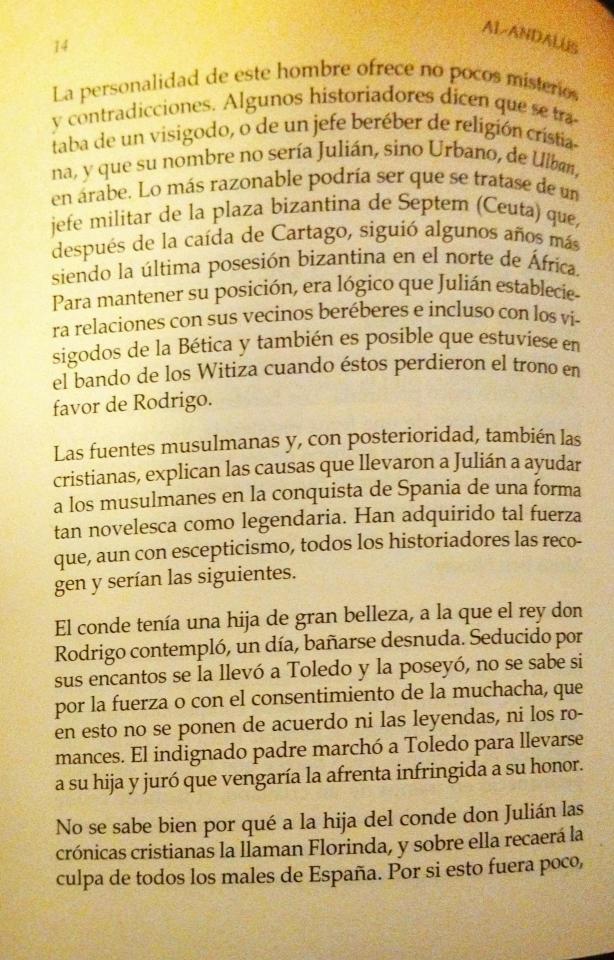
The personality of this man offers many mysteries and contradictions. Some historians say that he was a Visigoth, or a Berber of Christian religion, and that his name would not be Julián, but Urban, from Ulban, in Arabic. The most reasonable thing could be that he is a military commander from the Byzantine square of Septem (Ceuta) which, after the fall of Carthage, continued to be the last Byzantine position in North Africa for a few more years. To maintain his position, it was logical that Julián established relations with his Berber neighbors and even the Visigoths of Baetica and it is also possible that he was on the side of the Witizas when they lost the throne in favor of Rodrigo.
The Muslim sources and, later, also the
Christians, explain the causes that led Julián to help the Muslims in the conquest of Spania in such a way
novel as well as legendary. They have acquired such strength that, even
with skepticism, all historians collect them and they would be the following.
The count had a daughter of great beauty, whom the king Rodrigo, one day, contemplated her bathing naked. Seduced by her charms he took her to Toledo and possessed her, it is not known if because of force or with the consent of the girl, who in this neither legends nor romances agree. The indignant father marched to Toledo to take his daughter and swore
that he would avenge the affront inflicted on her honor.
It is not well known why the daughter of Count Don Julián is called Florinda in Christian chronicles, and on her will fall the
blame for all the ills of Spain. As if this were not enough,
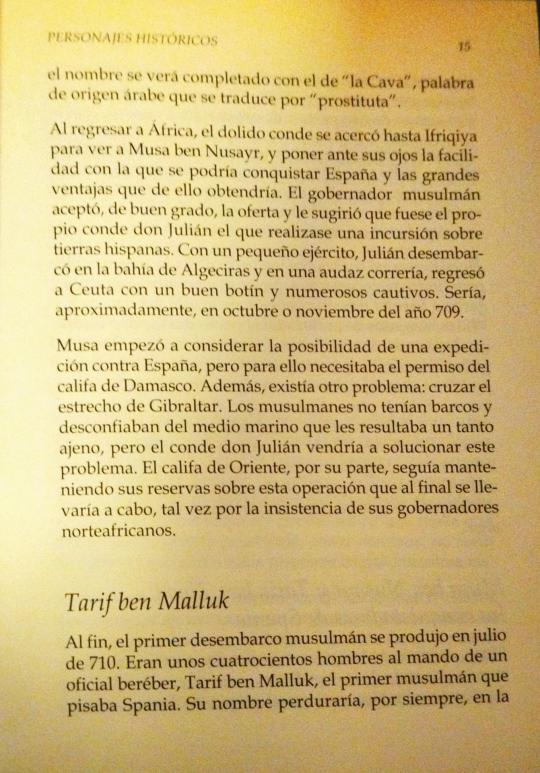
the name will be completed with “la Cava”, a word of Arabic origin which translates to "prostitute".
Upon returning to Africa, the hurt count went to Ifriqiya to see Musa ben Nusayr, and put before his eyes the ease with which one could conquer Spania and the great advantages that would be obtained from it. The Muslim governor willingly accepted the offer and suggested that it would be Count Don Julián himself who carried out an incursion onHispanic lands. With a small army, Julian landed in the bay of Algeciras and in a daring raid, he returned to Ceuta with good loot and numerous captives. It would be approximately October or November of the year 709.
Musa began to consider the possibility of an expedition against Spania, but for this he needed the permission of the Caliph of Damascus. In addition, there was another problem: crossing the Strait of Gibraltar. The Muslims did not have ships and distrusted the marine environment that they considered a bit strange, but Count Don Julián would come to solve this problem. The Caliph of the East, for his part, continued to maintain his reservations about this operation that would ultimately be carried out, perhaps because the insistence of their North African governors.
Tarif ben Malluk
Finally, the first Muslim landing occurred in July 710. There were about four hundred men under the command of a Berber officer, Tarif ben Malluk, the first Muslim to set foot in Spania. His name would last, forever, in the
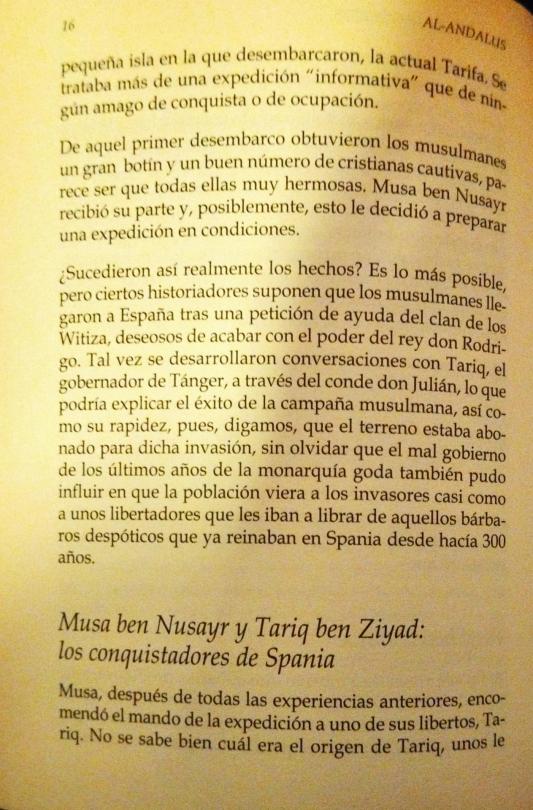
small island where they landed, the current Tarifa. It was more of an “informative” expedition than a threat of conquest or occupation.
From that first landing the Muslims obtained Muslims obtained a
great booty and a good number of captive Christian women, it seems to be
that all of them are very beautiful. Musa ben Nusayr received his part and, possibly, this decided him to prepare a proper expedition.
Did the events really happen like this? It is the most possible, butcertain historians suppose that the Muslims came to
Spania after a request for help from the Witiza clan, eager to put an end to the power of King Don Rodrigo. Maybe
conversations took place with Tariq, the governor of Tangier, through Count Don Julián, which could explain the
success of the Muslim campaign, as well as its speed, therefore, let's say that the ground was fertile for said invasion,
without forgetting that the bad government of the last years of the
Gothic monarchy could also influence the population to see the invaders almost as if they were liberators who were going to
rid of those despotic barbarians who already reigned in Spania for 300 years.
Musa ben Nusayr and Tariq ben Ziyad:
the conquerors of Spania
Musa, after all the previous experiences, entrusted the command of the expedition to one of his freedmen, Tariq.
It is not well known what Tariq's origin was, some
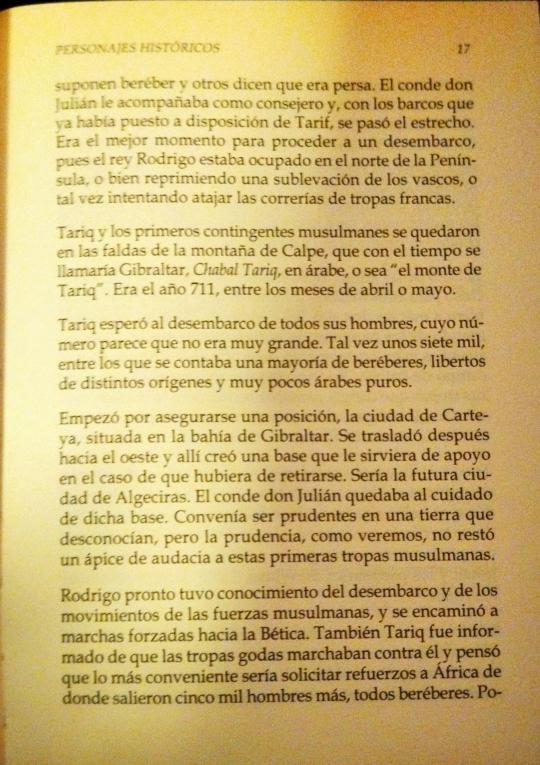
assume he was Berber and others say he was Persian. Count Don Julián
accompanied him as a counselor and, with the ships that he had already put to
Tarif's disposition, the strait was crossed. It was the best time to proceed to landing, since King Rodrigo was busy in the
north of the Peninsula, or repressing an uprising of the Basques, or perhaps trying to stop the raids of Frankish troops.
Tariq and the first Muslim contingents stayed in the foothills of the Calpe mountain, which in time would be called Gibraltar, Chabal Tariq, in Arabic, that is, “the mountain of Tariq.” It was the year 711,
between the months of April or May.
Tariq waited for all his men to disembark, whose number seems like it wasn't very big. Perhaps seven thousand, among whom the majority were Berbers, freedmen of different origins and
very few pure Arabs.
He began by securing a position, the city of Carteya, located in the bay of Gibraltar. He then moved west and there created
a base that would serve as support in the event that it had to backing out. It would be the future city of Algeciras. Count Don Julián was in the care of said base. It was advisable to be cautious in a
land that they did not know, but prudence, as we will see, did not took less audacity to these first Muslim troops.
Rodrigo soon learned of the landing and the movements of the Muslim forces, and set out on marches forced towards Baetica. Tariq was also informed that the
Gothic troops were marching against him and he thought that the most convenient
would be to request reinforcements from Africa where five thousand men came from
more, all Berbers. Po-
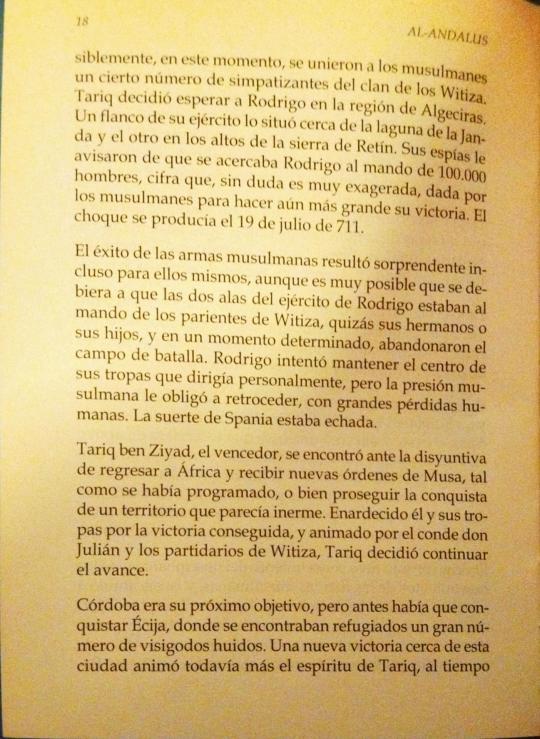
ssibly, at this time, the Muslims were joined by a certain number of sympathizers of the Witiza clan. Tariq decided
wait for Rodrigo in the region of Algeciras. One flank of his army was placed near the Janda lagoon and the other on the heights of the Retín mountain range. His spies warned him that Rodrigo was approaching
commanding 100,000 men, a figure that is undoubtedly very exaggerated, given by the Muslims to make even bigger their victory. The clash occurred on July 19, 711.
The success of Muslim weapons was surprising even for themselves, although it is very possible that it was because
the two wings of Rodrigo's army were commanded by the relatives of Witiza, perhaps his brothers or his children, and in a certain moment, they left the battlefield. Rodrigo tried to hold the center of his troops that he led personally, but Muslim pressure forced him to retreat,
with great human losses. Spania's luck was
cast.
Tariq ben Ziyad, the victor, found himself faced with the dilemma of returning to Africa and receiving new orders from Musa, as had been scheduled, or continuing the conquest of a territory that seemed defenseless. He and his troops were enraged by the victory achieved, and encouraged by Count Don Julián and Witiza's supporters, Tariq decided to continue the advance.
Córdoba was their next objective, but first they had to conquer Écija, where a large number of escaped Visigoths were taking refuge. A new victory near this city encouraged Tariq's spirit even more, while
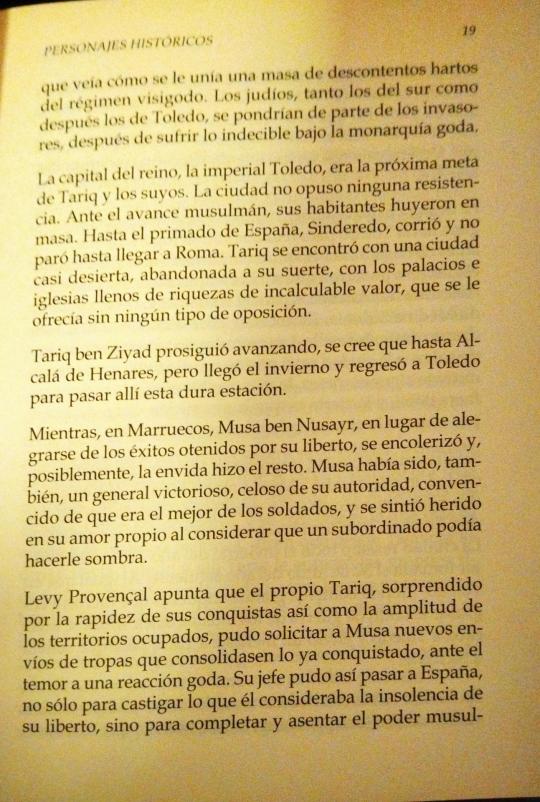
he saw how he was joined by a mass of dissatisfied people fed up with the Visigothic regime. The Jews, both those of the south and later those of Toledo, would side with the invaders, after suffering the unspeakable under the Gothic monarchy.
The capital of the kingdom, the imperial Toledo, was the next goal of Tariq and his people. The city did not put up any resistance. Faced with the Muslim advance, its inhabitants fled. Even the primate of Spania, Sinderedo, ran away and did not stop until he reached Rome. Tariq found an almost deserted city, abandoned to its fate, with palaces and churches full of riches of incalculable value, which were offered to him without any type of opposition.
Tariq ben Ziyad continued advancing, it is believed as far as Alcalá de Henares, but winter arrived and he returned to Toledo to spend this hard season there.
Meanwhile, in Morocco, Musa ben Nusayr, instead of rejoicing at the successes achieved by his freedman, became angry and, possibly, envy did the rest. Musa had also been a victorious general, jealous of his authority, convinced that he was the best of soldiers, and he felt hurt in his self-esteem when he considered that a subordinate could overshadow him.
Levy Provençal points out that Tariq himself, surprised by the speed of his conquests as well as the breadth of the occupied territories, was able to request new shipments of troops from Musa to consolidate what had already been conquered, fearing a Gothic reaction. His leader was thus able to go to Spania, not only to punish what he considered the insolence of his freedman, but to complete and establish Mus-
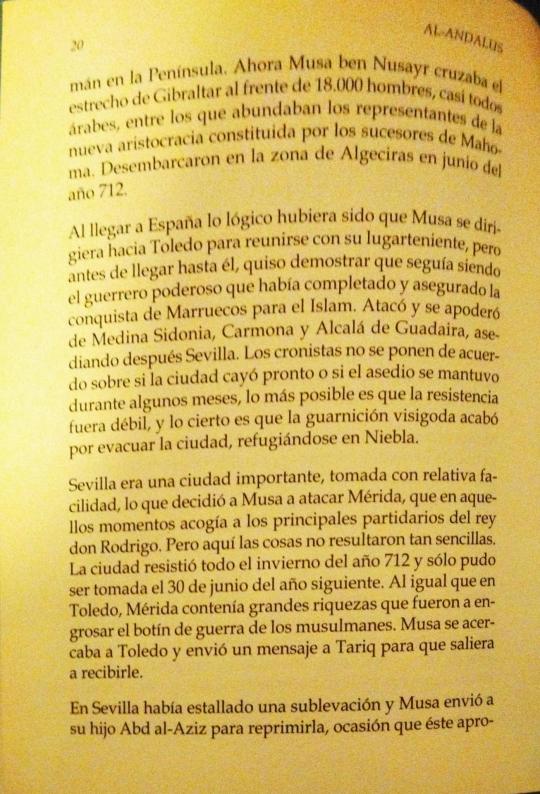
lim power on the Peninsula. Now Musa ben Nusayr crossed the Strait of Gibraltar at the head of 18,000 men, almost all Arabs, among whom were many representatives of the new aristocracy formed by the successors of Muhammad. They landed in the area of Algeciras in June of the year 712.
Upon arriving in Spania, it would have been logical for Musa to head towards Toledo to meet with his lieutenant, but before reaching him, he wanted to demonstrate that he was still the powerful warrior who had completed and ensured the conquest of Morocco for Islam. He attacked and took control of Medina Sidonia, Carmona and Alcalá de Guadaira, later besieging Seville. The chroniclers do not agree on whether the city fell soon or if the siege continued for a few months; it is most likely that the resistance was weak, and the truth is that the Visigoth garrison ended up evacuating the city, taking refuge in Niebla.
Seville was an important city, taken with relative ease, which decided Musa to attack Mérida, which at that time hosted the main supporters of King Don Rodrigo. But here things were not so simple. The city resisted throughout the winter of 712 and could only be taken on June 30 of the following year. As in Toledo, Mérida contained great riches that added to the war loot of the Muslims. Musa was approaching Toledo and sent a message to Tariq to come out to meet him.
An uprising had broken out in Seville and Musa sent his son Abd al-Aziz to suppress it, an opportunity that he took advantage
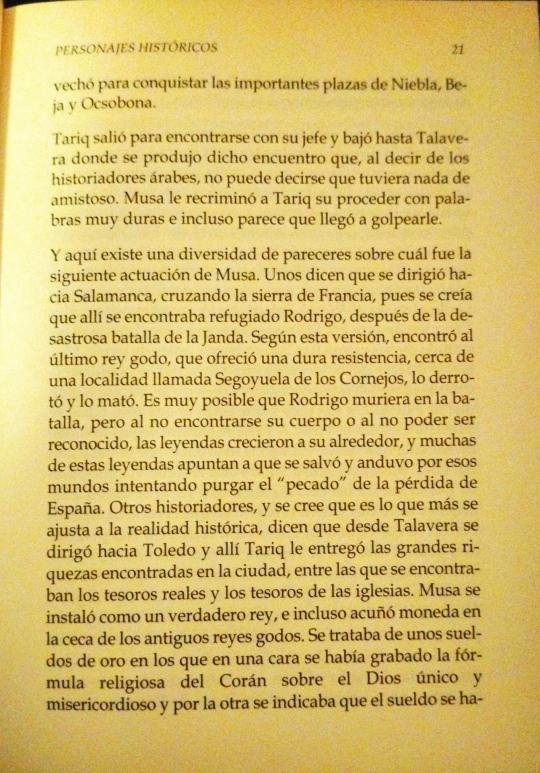
to conquer the important squares of Niebla, Beja and Ocsobona.
Tariq left to meet his boss and went down to Talavera where this meeting took place which, according to Arab historians, cannot be said to have had anything friendly. Musa reproached Tariq for his behavior with very harsh words and it seems that he even hit him.
And here there is a diversity of opinions about what Musa's next performance was. Some say that he headed towards Salamanca, crossing the Sierra de Francia, since it was believed that Rodrigo was taking refuge there after the disastrous battle of La Janda. According to this version, he found the last Gothic king, who offered tough resistance, near a town called Segoyuela de los Cornejos, defeated him and killed him. It is very possible that Rodrigo died in battle, but since his body was not found or could not be recognized, legends grew around him, and many of these legends suggest that he was saved and walked through those worlds trying to purge the “sin” of the loss of Spania. Other historians, and it is believed that this is what most closely corresponds to historical reality, say that from Talavera he headed towards Toledo and there Tariq gave him the great riches found in the city, among which were the treasures royals and the treasures of the churches. Musa installed himself as a true king, and even minted coins in the mint of the ancient Gothic kings. They were golden salaries on which the religious formula of the Koran about the only and merciful God had been engraved on one side and on the other it indicated that the salary had been
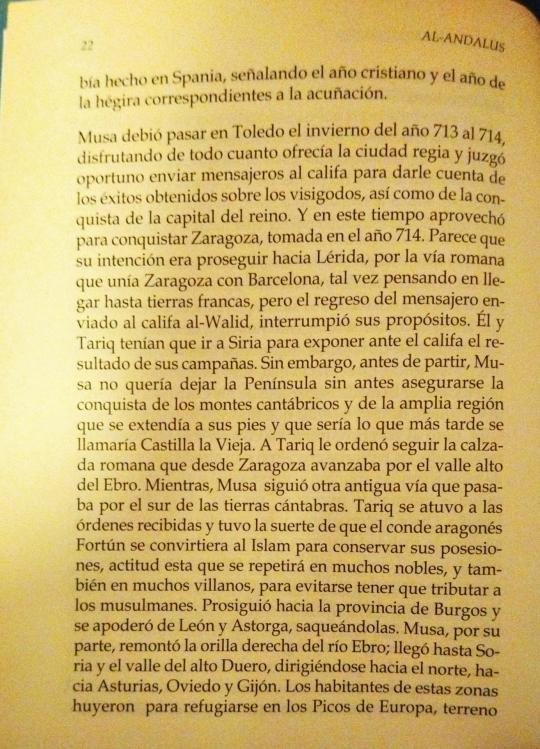
made in Spania, indicating the Christian year and the year of the hegira corresponding to the coinage.
Musa had to spend the winter from 713 to 714 in Toledo, enjoying everything that the royal city offered and considered it appropriate to send messengers to the caliph to inform him of the successes obtained against the Visigoths, as well as the conquest of the capital of the Kingdom. And at this time he took the opportunity to conquer Zaragoza, taken in the year 714. It seems that his intention was to continue towards Lleida, along the Roman road that linked Zaragoza with Barcelona, perhaps thinking of reaching Frankish lands, but when the messenger returned sent to the caliph al-Walid, interrupted his purposes. He and Tariq had to travel to Syria to present the results of their campaigns to the caliph. However, before leaving, Musa did not want to leave the Peninsula without first securing the conquest of the Cantabrian Mountains and the wide region that extended at its feet and which would later be called Old Castile. Tariq was ordered to follow the Roman road that advanced from Zaragoza through the upper Ebro valley. Meanwhile, Musa followed another ancient route that passed through the south of the Cantabrian lands. Tariq followed the orders he received and was lucky that the Aragonese count Fortún converted to Islam to preserve his possessions, an attitude that was repeated by many nobles, and also by many villains, so as not to have to pay taxes to Muslims. He continued towards the province of Burgos and took control of León and Astorga, plundering them. Musa, for his part, went up the right bank of the Ebro River; He reached Soria and the upper Duero valley, heading north towards Asturias, Oviedo and Gijón. The inhabitants of these areas fled to take refuge in the Picos de Europa mountain range, terrain
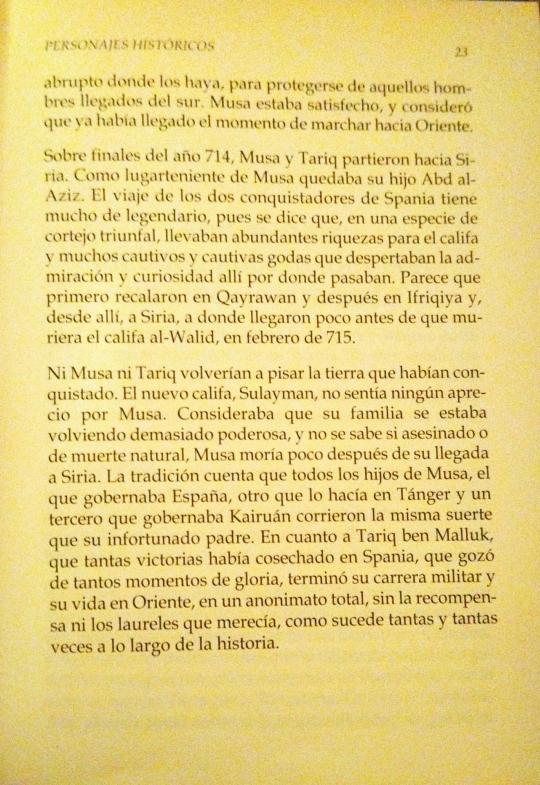
very abrupt, to protect themselves from those men arriving from the south. Musa was satisfied, and considered that the time had come to march towards the East.
Around the end of the year 714, Musa and Tariq left for Syria. Musa's lieutenant was his son Abd al-Aziz. The journey of the two conquerors of Spania is very legendary, since it is said that, in a kind of triumphal procession, they brought abundant riches for the caliph and many Gothic captives who aroused admiration and curiosity wherever they passed. It seems that they first landed in Qayrawan and then in Ifriqiya and, from there, to Syria, where they arrived shortly before the death of the Caliph al-Walid, in February 715.
Neither Musa nor Tariq would return to set foot on the land they had conquered. The new caliph, Sulayman, had no appreciation for Musa. He considered that his family was becoming too powerful, and it is not known whether murdered or a natural death, Musa died shortly after his arrival in Syria. Tradition says that all of Musa's sons, the one who ruled Spania, another who ruled in Tangier and a third who ruled Kairouan, suffered the same fate as their unfortunate father. As for Tarif ben Malluk, who had won so many victories in Spania, who enjoyed so many moments of glory, he ended his military career and his life in the East, in total anonymity, without the reward or laurels he deserved, as happens so many times throughout history.
#bookblr#historyblr#al andalus#al andalus. historical figures#al-andalus. personajes históricos#al andalus history#book scans#the conquest of al-andalus#fath al andalus#la conquista de al andalus#tariq ibn ziyad#musa ibn nusayr#tarif ibn malik#conde don julián#count don julián#julián de ceuta#spanish history
10 notes
·
View notes
Text

En el año 1085, Alfonso VI conquista Toledo y establece allí su corte. Los reinos de al-Andalus, temerosos por el avance cristiano, reclaman la ayuda de los almorávides del norte de África, una ayuda que les volverá pronto en contra. Al-Mutamid, rey de Sevilla, solicita ayuda a Alfonso VI, utilizando como embajadora a la bella e inteligente Zaida. La pasión nace de inmediato entre el rey y la cortesana, pero la corte no está dispuesta a aceptar ese amor ni las consecuencias que traerían para el reino cristiano un descendiente con sangre musulmana. La intriga política y la pasión se enfrentan a un contexto histórico de una gran riqueza, pues pone en contacto a dos modos de pensar y a personajes, como Zaida y Alfonso VI, de una sorprendente modernidad.
4 notes
·
View notes
Text
La balada de la reina descalza - Novela histórica
Entre los personajes históricos que poblaron el Al-Andalus exquisito, culto y refinado del siglo XI se encontraba Al-Mutamid, tercer rey de la taifa sevillana. Poeta, guerrero y protector de artistas, su vida proporciona a la insaciable necesidad popular de leyendas una de las más bellas historias de amor.
La balada de la reina descalza se descubre como un texto sorprendente pero sólido,…
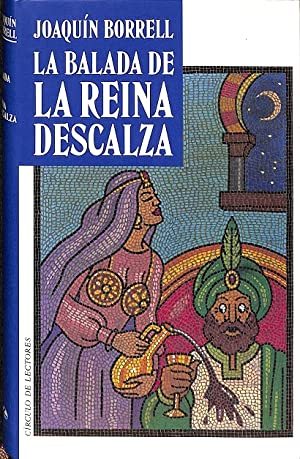
View On WordPress
0 notes
Text
Al-Ándalus

Sigue un breve recuento histórico de la dominación musulmana en Iberia:
En el año de 711 Táriq ibn Ziyad, un líder militar bereber originario de lo que hoy constituye Marruecos, desembarcó en la bahía de Algeciras al mando de una fuerza de 7.000 hombres también bereberes en su mayoría . Desde el peñón de Gibraltar (del árabe 'Ŷebel at-Tariq', montaña de Tariq) dirigió ataques sucesivos hacia Andalucía. La península Ibérica estaba entonces bajo el poder de los visigodos. El rey de los visigodos, Rodrigo o Roderic, se enfrentó a los musulmanes en la batalla del río Guadalete donde fue derrotado y muerto. El gobernador yemení de Ifriqiya (actual Tunez) Musa ben Nusayr se unió junto con su ejército de 18.000 hombres a las fuerzas de Tariq y juntos emprendieron la conquista del resto de la península. Toledo, capital del muy centralizado reino visigodo, fue tomada antes de terminar el año 711 y el resto del territorio ibérico, a excepción de Asturias en el norte, cayó bajo control de los musulmanes en unos cuantos años. Tanto Tariq como Musa habían batallado a nombre del Califato Omeya que tenía su base en Damasco.
Los conquistadores musulmanes de la península ibérica le dieron un nuevo nombre a esta, Al-Ándalus. El lenguaje y la cultura berebero-árabe fueron impuestos sobre la población y ocurrieron muchas conversiones al islamismo pero aún las personas que no se convirtieron aprendieron a hablar árabe y fueron denominados mozárabes. También hubo inmigración musulmana desde el norte de África.
En el año de 750 el Califato Omeya de Damasco fue derrotado por los abasíes quienes constituyeron el Califato Abasí con su sede en la ciudad de Baghdad. Los principales omeyas fueron masacrados a excepción de un solo miembro de la familia, Abderramán, quien escapó y terminó refugiándose en Al-Ándalus. Abderramán estableció un emirato independiente del Califato de Baghdad que duró hasta el año de 929.
En el año de 929 se estableció el Califato Fatimí en el norte de África. Los fatimíes se proclamaban como los directos descendientes de la hija del profeta Mahoma, Fátima, y de su esposo y primo Alí. Eran chiitas y su propósito era el de tomar el control político, espiritual, y militar de todo el mundo musulmán. Tenían por lo tanto como objetivo acabar con el Califato Abasí de Baghdad y también sacar del poder a los omeyas de Al-Andalus.
En vista de esta nueva amenaza venida del norte de África el emir Abderramán III decidió fundar un nuevo califato en Al-Ándalus. Éste fue proclamado en el año de 929 y su sede fue establecida en la ciudad de Córdoba.
Durante los años que duró el califato, Córdoba se convirtió en una ciudad de gran importancia cultural, política, y económica y llegó a ser una de las tres ciudades más pobladas del mundo junto con Constantinopla y Baghdad. La agricultura era de las más productivas de Europa y los califas emprendieron obras arquitecturales importantes como la ciudad palatina de Madínat al-Zahra y la Mezquita de Córdoba. La ciudad fue dotada además con cerca de 70 bibliotecas y se convirtió en un imán cultural que atraía a estudiosos de toda Europa. Muchas obras clásicas griegas y romanas fueron traducidas del árabe al latín durante este período lo que sirvió para esparcir el conocimiento clásico por todo el continente. Tuvo un apogéo el estudio de ciencias como la astronomía, la medicina, la filosofía y también artes como la poesía. Entre los famosos eruditos de esta y subsiguientes épocas se pueden mencionar al médico Avenzoar, el filósofo Averroes y el teólogo judío Maimónides.

En el año de 977 surgió un nuevo personaje fuerte en la historia de Al-Andalus. Se trata de Muhammad ibn Abi Amir o Almanzor, hayib o chambelán del débil califa Hisham II, y quien se convirtió en el gobernante de facto del califato. Bajo su liderazgo se emprendieron más de 50 campañas militares exitosas contra los reinos cristianos de León, Castilla, Pamplona, y Cataluña, forzándolos a reconocer la soberanía del califato y a pagar tributos. La muerte de Almanzor en 1002 hizo desatar una guerra civil entre sus herederos y los miembros de la línea de sucesión omeya. El califato no resistió a esta pugna y en el año de 1031 se disolvió, estableciéndose en su lugar pequeños reinos independientes musulmanes llamados taifas.
Las débiles taifas empezaron a ser atacadas por los reinos cristianos del norte y después de que los cristianos se tomaran a Toledo en 1085 decidieron llamar en su ayuda a los guerreros islamistas nómadas del norte de África llamados almorávides. Los almorávides unificaron a Al-Ándalus mas no lograron impedir la continuación de los ataques cristianos.
A los almorávides sucedieron los almohades (también del norte del África) quienes hicieron su incursión en la península en 1172. Se logró una cierta estabilidad que duró algunas décadas. Sin embargo los almohades fueron definitivamente derrotados por una coalición cristiana en el año de 1218 en la Batalla de Navas de Tolosa que les brindó a los cristianos la perspectiva de conquistar todo el valle del río Guadalquivir (actual Andalucía).
En los años de 1230 a 1250 la mayoría de las taifas musulmanas fueron conquistadas por los reinos cristianos de Castilla, León, y Aragón.
El último reino musulmán en la península fue el Emirato Nazarí de Granada establecido en el año de 1238 por Mohamed-Ben-Nazar. Este reino logró una cierta tranquilidad y prosperidad gracias al hecho de que pagaba tributo al reino de Castilla y a cambio obtenía la paz. Granada se volvió un centro comercial importante entre Europa y el Magreb. También se convirtió en un centro cultural de consideración que a la vez servía de refugio a los musulmanes que huían de la Reconquista. A pesar de tener como defensa natural a la Sierra Nevada el Reino Nazarí fue paulatinamente perdiendo territorio frente a la Corona de Castilla.
Tras la unión de Isabel I de Castilla y Fernando II de Aragón en 1479 se consolidó el poder cristiano en la península. Los reyes se concentraron en la toma de Granada como última etapa en el proceso de la Reconquista. La llamada Guerra de Granada duró diez años desde 1482 hasta 1492 tras los cuales se firmaron las Capitulaciones de Granada entre los victoriosos Reyes Católicos y el sultán Boabdil.
El tratado de paz garantizaba derecho de permanencia en territorio ibérico a los musulmanes, sin necesidad de convertirse, a condición de que fueran súbditos pacíficos de la corona. Sin embargo en los siguientes años se emprendió con ímpetu la conversión forzosa de los musulmanes al cristianismo. Mezquitas fueron convertidas en iglesias y libros islámicos fueron quemados.
Los descendientes de los musulmanes de Al-Ándalus se denominaron moriscos. Aunque se convirtieron formalmente al cristianismo mantuvieron sus creencias secretamente. La represión por parte de los reyes cristianos continuó durante el siglo XVI y Felipe II prohibió los cantos tradicionales y el uso de la lengua árabe. Esta intolerancia culminaría en 1609 con la Expulsión de los Moriscos.
Historiadores modernos que han estudiado este período consideran que muchos moriscos eludieron el decreto de expulsión y se quedaron en la península y que otros grupos emigraron para después regresar. En cualquier caso los moriscos en suelo español terminaron integrándose al resto de la población.
La herencia que dejaron siete siglos de ocupación musulmana en Iberia es sobre todo de caracter cultural. Todavía se pueden admirar las obras arquitectónicas de Al-Ándalus como por ejemplo la Mezquita de Córdoba o el palacio de La Alhambra. Alrededor de 4.000 palabras de origen árabe son utilizadas hoy en día en la lengua castellana.
Reciéntemente se han llevado a cabo estudios genéticos de los pobladores de España y se estima que uno de cada 10 españoles tiene antepasados venidos de África del Norte. Esta es una prueba ciéntifica de que poblaciones musulmanas de tamaño importante se integraron a la sociedad cristiana ibérica después de la Reconquista.
youtube
1 note
·
View note
Video
AL ANDALUS-ARTE-PINTURA-RETRATOS-REYES-HISTORIA-ESPAÑA-ALHAMBRA-ARQUITECTURA-INTERIOR-SALON-TRONO-GRANADA-ARTISTA-PINTOR-ERNEST DESCALS por Ernest Descals
Por Flickr:
AL ANDALUS-ARTE-PINTURA-RETRATOS-REYES-HISTORIA-ESPAÑA-ALHAMBRA-ARQUITECTURA-INTERIOR-SALON-TRONO-GRANADA-ARTISTA-PINTOR-ERNEST DESCALS- Interiores de La Alhambra en Granada, retratos de reyes y califas de AL ANDALUS en la historia de España,el Salón del Trono del palacio y el personaje con la arquitectura mulsulmana. Pintura sobre papel de 50 x 70 centímetros del artista pintor Ernest Descals pintando los personajes históricos en su hábitat.
#GRANADA#AL ANDALUS#HISTORIA#ESPAÑA#SPAIN#HISTORY#CALIFA#CALIFAS#EMIR#EMIRES#REY#REYES#KING#KINGS#CULTURA#ARQUIETCTURA#SALON DEL TORNO#INTERIOR#INTERIORES#PERSONAJE#PERSONAJES#PORTRAIT#RETRATO#RETRATOS#MUSULMANES#GENERALIFE#PINTAR#PINTANDO#PAINTING#PEOPLE
1 note
·
View note
Text
Banu Qasi: Los hijos de Casio
Destinado desde su nacimiento a gobernar y dirigir a su pueblo, Musa ibn Musa toma su nombre del gran conquistador de la Península, que varias generaciones antes había alcanzado el valle del Ebro para someter a clientela a Casio, el conde visigodo que dominaba la zona. Sus descendientes, los Banu Qasi, ya convertidos al Islam, están llamados a desempeñar un papel más que relevante en la agitada región de la Marca Superior durante el siglo IX de nuestra era. En la apasionante trama concurren personajes históricos de excepcional relevancia, cuyas trayectorias se entrecruzan no sólo por motivos políticos, sino también por lazos familiares. Junto al caudillo árabe, dos de sus coetáneos comparten el protagonismo: por una parte, Iñigo Arista, hermano de madre de Musa, que en esta época ha de convertirse en el primer rey de Pamplona. Por otra, el emir de Córdoba, Abd al Rahman II, gran artífice del esplendor político y cultural de Al Ándalus en este período. En un escenario caracterizado por el enfrentamiento entre las dos grandes formas de contemplar el mundo entonces conocido, el Islam y el Cristianismo, Musa e Iñigo tratan de mantener en la frontera, entre el Ebro y los Pirineos, la soberanía y la independencia de sus pueblos colocando sus lazos familiares y la fuerza de la sangre por delante de sus diferencias de credo. Sometidos a los vaivenes de la Historia, no son conscientes de que ambos se convertirán, también, en sus protagonistas. Banu Qasi combina el crudo relato de la guerra, las intrigas y las rebeliones con la descripción de la vida en Al Andalus hace más de mil años. Sus inolvidables personajes se nos revelan en toda su complejidad y la riqueza de detalles es fruto de una investigación minuciosa. En suma, un relato basado en hechos históricos que logra enganchar al lector, permitiéndole acceder a un mundo casi desconocido que resulta fascinante.
La entrada Banu Qasi: Los hijos de Casio se publicó primero en 🥇 Lectulandia - Descarga eBooks Gratis en formato ePub y PDF.
https://ift.tt/2UCCXPR
#Lectulandia
2 notes
·
View notes
Text
LA ALCAZABA CENTRA SUS ACTIVIDADES DE FEBRERO Y MARZO EN EL DÍA DE ANDALUCÍA, LA MUJER Y EL RESPETO AL PATRIMONIO CULTURAL.
Entre las actividades lúdicas y culturales que ha elaborado el Conjunto Monumental de la Alcazaba de Almería para los próximos dos meses habrá visitas teatralizadas, temáticas, en clave de género, talleres para niños, charlas y conferencias sobre conservación del patrimonio alcazabeño y una jornada performativa enfocada en redes sociales y patrimonio cultural. Todo ello alrededor de dos efemérides que marcan el calendario, el 28 de febrero, por el Día de Andalucía y el 8 de marzo, por el Día de la Mujer. Gran parte de las actividades están destinadas al público familiar, aunque no se olvidan de los más peques de la casa, y los adultos, con la intención siempre de generar experiencias para mejorar, conservar, enseñar, proteger, valorar y respetar el patrimonio cultural. Se pretende desde el Conjunto, sembrar para recoger mañana.
Día de Andalucía.

La Alcazaba ha preparado para el día grande de Andalucía diferentes actividades para todos los públicos. Así, el sábado 23 de febrero tendrá lugar la visita teatralizada para público familiar 'Una gozada de Alcazaba' del grupo Viajar en el tiempo. Con ella las familias con los pequeños de la casa se acercarán de forma dinámica, divertida y original a la historia de la Alcazaba y de Almería. Se pasearán por los rincones más emblemáticos del monumento y, personajes como Amina, Drisia, Baraka y Alí, habitantes de la fortaleza desde hace más de 1.000 años, serán los encargados de narrar los contenidos histórico-culturales.
El domingo 24 tendrá lugar la charla interdisciplinar La conservación del frente sur de la Alcazaba: patologías y restauraciones desde el siglo XX y XXI, a cargo de Pedro Gurriarán, arquitecto, Rosa Morales, arqueóloga, Cruz Ramos, restauradora y Arturo del Pino, director del Conjunto. La existencia de humedades en muchos de los paños de la Alcazaba ha llamado la atención de profesionales y personal de la administración desde hace tiempo. Proliferan especialmente en el frente meridional del monumento, y se manifiestan mediante la presencia de grandes manchas, distribuidas de forma aleatoria sobre los paramentos.
Por ello, desde el pasado mes de julio se están llevando a cabo diferentes trabajos en un lienzo de 12 metros, para intentar extraer conclusiones a la hora de conocer el origen y erradicar la presencia de humedades, de modo que puedan ser extrapoladas a otras zonas de la fortaleza. Para ello se han ejecutado trabajos arqueológicos en su trasdós, con objeto de verificar la presencia de redes de saneamiento enterradas o puntos de desagüe originales en la muralla. Igualmente, se pretendía conocer arqueológicamente el origen del paño y su evolución. Una vez realizada la intervención arqueológica se acometió un completo trabajo analítico de los materiales edilicios de la muralla a cargo de especialistas del Grupo de Investigación TEP-198 “Materiales y Construcción” adscrito al Dpto. de Construcciones Arquitectónicas II de la Universidad de Sevilla. En esta charla se hablará de alguna de sus claves.
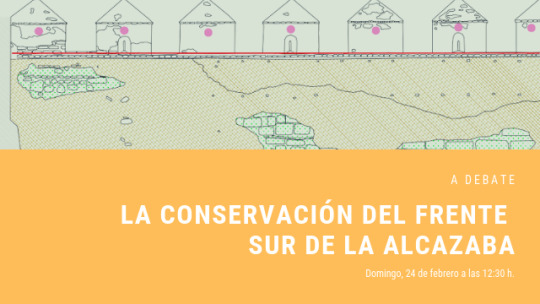
El mismo jueves 28 de febrero, el Conjunto ha programado dos actividades, por un lado una visita interpretada para disfrutar de la naturaleza, la historia, la arqueología y de las inmejorables vistas sobre el mar y la ciudad de la mano de los Informadores Culturales; y otra, al Enclave arqueológico Puerta de Almería, donde el visitante podrá acercarse a los vestigios arqueológicos romanos conservados, una factoría de salazones, así como a una de las puertas de la muralla islámica que cerraba la ciudad por el sur.
Además, para el 1º de marzo, el Conjunto ofertará el taller para niños Alicatando nuestras casas, para edades entre 6 y 12 años. El taller tiene como objetivo conocer las viviendas islámicas, su forma, distribución, decoración y contenido. En él los peques decorarán las paredes de las Casas Árabes usando la técnica del alicatado. Para ello a los niños se les proporcionará el material necesario para llevar a cabo esta decoración. Esta actividad irá acompañada de explicaciones sencillas por parte de los técnicos, sobre materiales de construcción, espacios funcionales de la casa, actividad que se desarrollaba en ella, etc.
Día de la Mujer.
El 8 de marzo se celebra el Día de la Mujer, y la Alcazaba desde hace tiempo viene apostando por su visita temática [Re]encuentro con el pasado. Mujeres tras los muros de la Alcazaba, un itinerario gratuito donde el contenido gira alrededor de las huellas femeninas conservadas a lo largo del tiempo en la Alcazaba. Muchas fueron las mujeres en al-Andalus que sobresalieron por su saber y sus obras a través la poesía, la música, la epigrafía, …igualmente conocidas fueron sus intrigas palaciegas y sus hábiles movimientos políticos, siempre planeados y efectuados desde la sombra y tras los muros. Con esta visita se pretende poner en valor el legado conservado y poco reconocido de las mujeres que habitaron Almería entre los siglos X-XV, y cuyo recuerdo aún pervive en la Alcazaba. A través de esta iniciativa se ofrece la oportunidad al visitante de descubrir el monumento desde una perspectiva más igualitaria y justa. La visita podrá realizarse en abierto los días 3 y 10 marzo a partir de las 12:30 horas, previa inscripción para mayores de 16 años. El día 7 de marzo se ofrecerá la misma al alumnado de 1º de bachillerato del IES. Alhamilla, y el 14 de febrero se ofrecerá a 33 mujeres del programa de TVE '7 días sin ellas' que visitarán el monumento.
El domingo 10 de marzo, también se ha preparado un nuevo taller para niños titulado El comercio en al-Mariyya, un divertido juego de mesa donde los niños de 6 a 12 años conocerán cómo era el intercambio comercial de la época de al-Mariyya -cultura, mercancías, personas, ... - y la importancia comercial de la ciudad andalusí.
Redes sociales y patrimonio cultural.
Consciente el Conjunto Monumental de la importancia de la redes sociales como vehículo para acercar el patrimonio, dedica de manera pionera una jornada a Redes sociales y patrimonio cultural, donde se plantea como punto de partida para evaluar y construir nuevas narrativas en torno a la Alcazaba desde una visión sociodigital del mismo de manera performativa. La jornada, que tendrá lugar el sábado 16 de marzo a partir de las 10:30 h., está pensada para la comunidad tuitera y instagramers del Conjunto. En ella se intentará dar respuesta a preguntas como ¿qué papel juega la comunidad digital en la gestión del patrimonio de la Alcazaba? ¿Realmente existe una comunidad digital vincula al patrimonio de la ciudad? ¿Cómo podemos introducir las redes sociales en las visitas guiadas tradicionales? ¿Deberían los gestores de patrimonio almeriense tener más presente estas estrategias de comunicación y a su comunidad digital? La inscripción y las bases de esta jornada que correrá a cargo de la museóloga Marian Alonso, se publicará en las redes del Conjunto en los próximos días.
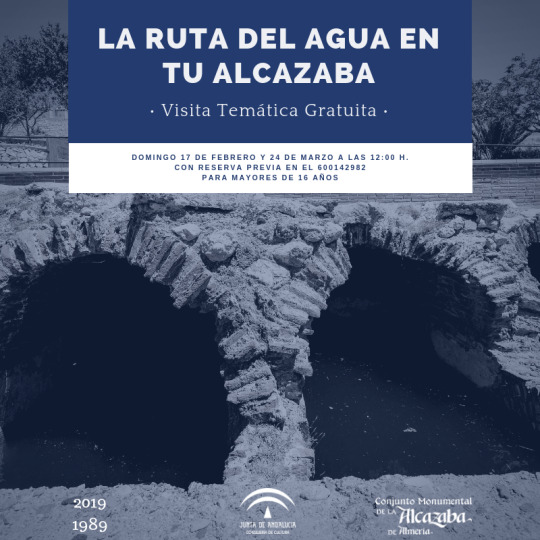
Visitas temáticas.
A lo largo de estos dos últimos años la Alcazaba ha ido elaborando visitas temáticas propias relacionadas con los contenidos del monumento. Así el 10 de febrero tendrá lugar 'La mirada de Prieto-Moreno. Obras y restauraciones en la Alcazaba durante el siglo XX'. Se trata de una visita por la formulación teórica y la práctica restauradora del arquitecto Francisco Prieto-Moreno [1907-1985] que durante cerca de cuarenta años intervino mediante diferentes obras en la fisonomía actual de la Alcazaba. Un itinerario que recorre los primeros intentos de conservación del conjunto desde su declaración como Monumento Histórico Artístico en 1931 con la figura de Leopoldo Torres Balbás, para llegar al análisis concreto de Prieto-Moreno, como ejemplo representativo de las propuestas que marcaron la restauración monumental durante la inmediata posguerra y las siguientes décadas del siglo XX.
El 31 de marzo será el turno para la ruta 'Alcazaba, patrimonio de cine', una visita temática organizada por el Conjunto Monumental de la Alcazaba en colaboración con la asociación Almeríacine cuyo objetivo es dar a conocer el valor de este patrimonio como escenario cinematográfico en el rodaje de un total de 32 películas y series televisivas, algunas tan emblemáticas como Indiana Jones y la última cruzada, Juego de Tronos, Marchar o morir, Conan el Bárbaro, o recientemente, Wonder woman.

También, dentro de las estrategias de conservación de nuestro legado cultural, el domingo 17 de marzo a las 12:30h. Tendrá lugar la charla 'Técnicas 3d en la restauración del patrimonio', a cargo de Lola Miralles, Gerardo Úbeda, arquitectos, y César Ordás, restaurador. Y es que el tratamiento del patrimonio supone para los técnicos que trabajan en ello un enorme reto, puesto que tienen que elevar el nivel y profundizar en los detalles minimizando los errores y maximizando el conocimiento previo del entorno en el que trabajan. Las herramientas 3d disponibles hoy en día (scanners láser 3d, scanners led, fotogrametría, impresión 3d ...) suponen un avance indiscutible en la forma en la que nos acercamos a estas intervenciones. Nada podrá jamás sustituir el conocimiento y la formación de los técnicos, pero sin duda, estas herramientas 3d sí que permiten trabajar con un grado de precisión milimétrico, permitiendo obtener resultados sorprendentes, estudiar piezas patrimoniales desde perspectivas inusuales y controlar la totalidad del proyecto desde los ordenadores.

Además, como viene siendo tradicional, todos los sábados del año el Conjunto ofrecerá visitas interpretadas al monumento a partir de las 12:00 horas bajo el título ¡Conoce tu Alcazaba!, donde los informadores del mismo acercarán éste de una manera distendida, pedagógica y gratuita a todos aquellos que quieran acercarse a ella.
Todas las actividades son gratuitas hasta completar el aforo. Para algunas de ellas es necesaria la reserva previa llamando al 600142982 de martes a domingo de 9:00 a 14:00 horas. Más información de las mismas a través de la página web o las redes sociales del Conjunto.
Descargar Boletín nº 1. Febrero-Marzo 2019.
#alcazabaalmería#actividades#cultura#arte#arqueología#gratis#conferencias#historia#arquitectura#niños#quéhacer#almería#Andalucía
0 notes
Text
La Alcazaba apuesta por los talleres de conciliación familiar y la arqueología en la programación de febrero y marzo .
El delegado territorial de Cultura, Turismo y Deporte, Alfredo Valdivia, acompañado por el director de la Alcazaba, Arturo del Pino, ha presentado esta mañana las actividades culturales y de ocio que se han programado para los meses de febrero y marzo. Según ha explicado el delegado, “ la intención de su departamento es normalizar la realización de actividades a lo largo de todo el año en la Alcazaba, con la puesta en marcha de un plan educativo en el cual estamos trabajando y que en cierta manera se está poniendo en práctica a través de diferentes actividades piloto para dar a conocer toda la actividad que genera la Alcazaba”.
Valdivia ha destacado los talleres de conciliación familiar en fines de semana y dirigidos al público infantil y familiar. Son talleres de tres horas, donde los niños se acercarán de diferentes maneras a la Alcazaba, divirtiéndose y aprendiendo a la vez, mientras sus padres tienen la oportunidad de conciliar familiar, laboral o personalmente esas horas, contribuyendo así a una estrategia que permita la construcción de un entorno social y laboral más saludable. En cuanto a los domingos, el Conjunto se lo dedicará a las familias y público en general, para que todos puedan disfrutar del patrimonio cultural y sus contenidos.
Otro de los programas a desarrollar será el acercamiento de la arqueología a la escuela, teniendo como referencia la propia Alcazaba como recurso didáctico más transversal en todo el currículo escolar. Para ello, ha explicado el delegado, se están elaborando diferentes materiales didácticos y talleres, entre ellos, uno de arqueología de la arquitectura que se realizará el próximo 14 de febrero. Va dirigido al alumnado de la asignatura Patrimonio Cultural y Artístico de Andalucía’. Con esta actividad piloto, lo que se pretende es acercar a los alumnos a la investigación arqueológica e identificar métodos y análisis de interpretación del patrimonio. A través de las estructuras emergentes y las huellas que aún hoy se conservan, se intentará reconstruir cómo eran los edificios, teniendo como marco privilegiado la denominada Torre de la Odalisca, en el área palacial del segundo recinto. Estas experiencias se llevarán a cabo en otras áreas como la investigación, la protección, la conservación o la comunicación del patrimonio cultural. En suma, afirma Arturo del Pino, “el objetivo fundamental de estos talleres y de nuestro plan educativo, no es otro que conocer, disfrutar y valorar nuestro patrimonio, contribuyendo de forma activa a su conservación como fuente de riqueza y legado que tiene que transmitirse a las generaciones futuras”.
En cuanto a las actividades organizadas por la Alcazaba, destacan los talleres infantiles de conciliación familiar, las actividades para familias, la música, yincana, una recreación histórica o una salida fotográfica nocturna a la alcazaba.
Talleres de conciliación familiar
“Los gatos en el Islam. Dibujando a Nika”. Este taller tiene la finalidad de hacer una mascota infantil de la Alcazaba; los participantes harán dibujos sobre la gata Nika. En el taller se introducirán explicaciones históricas sobre la Alcazaba, la religión en el Islam, y la propia historia de la gata Nika y de su abuela Matilda, felinos que nos acompañan desde hace muchos años en la Alcazaba. De todos los dibujos realizados, se elegirá uno para representarla. El taller será los días 18 y 25 de febrero, a las 11.00 h. El aforo será de 25 participantes con edades comprendidas entre los 8 y los 12 años.
“¡Juega y disfruta la Alcazaba!” se llevará a cabo los días 18 y 25 de febrero a las 12.30 horas, y su objetivo principal es dar a conocer el contenido histórico y cultural del conjunto monumental a través del juego. Para ello, los niños habrán de superar diferentes obstáculos y pruebas en equipo, con diferentes contenidos temáticos vinculados a la historia del monumento y de la ciudad. Además, podrán elaborar una original tarjeta, que tendrá como protagonista la Alcazaba. El taller está disponible para 25 participantes con edades comprendidas entre 8 y 12 años.
'Yincana en nuestra Alcazaba', tendrá lugar el 4 y el 18 de marzo de 11.00 a 14.00 horas para niños con edades comprendidas entre los 6 y 12 años de edad. Se proponen dos actividades con dos temáticas y dinámicas diferentes, y una duración aproximada de tres horas.
'Yincana en nuestra alcazaba: descubriendo las partes de nuestra fortaleza islámica', tiene como objetivo que los niños identifiquen los elementos que forman un recinto fortificado de época islámica y las características de cada uno de ellos (entradas, torres, murallas, aljibe …).
'Vivienda andalusí: alicatando nuestra casa', tiene como objetivo conocer las viviendas islámicas, su forma, distribución, decoración y contenido.
'Cuentos de la Alcazaba para niños', a cargo de María Campra, su autora, el domingo 12 de marzo a las 12.00 horas, en la ermita del segundo recinto. La actividad está dedicada para todos los públicos, especialmente para las familias, y consistirá en narrar diversos cuentos y en la realización de diversos juegos a su alrededor. El aforo estará limitado por orden de llegada.
Música
Concierto de música: 'Metal Cambra' en directo. El concierto será el viernes 17 de marzo a las 20.00 horas en el muro de la Vela. 'Metal Cambra' nació en 2008 tras la experiencia en diferentes agrupaciones de miembros del grupo, con carácter instrumental y con vocación de trascender la sencilla etiqueta de 'rock celta' para fusionar el rock con el foll en todo su espectro, pero sin cerrarse a ninguna influencia musical. Para ello, se decidió contar con músicos de experiencia musical e influencias diversas, pero que compartían el mismo objetivo. El concierto está organizado por la Universidad de Almería en colaboración con la Delegación Territorial de Cultura, Turismo y Deporte. La entrada es libre y gratuita hasta completar aforo.
Recreación histórica
“¡Que vienen los piratas!” es una actividad llevada a cabo por Vikings Southern (Vikingos del Sur) destinada a público familiar y curiosos, que tendrá lugar el domingo 26 de marzo entre las 11.00 y las 14.00 horas en la explanada del Muro de la Vela del primer recinto y torres circundantes. La entrada es libre hasta completar aforo.
La recreación histórica se compone de:
El asalto a Al-Mariyya
Un grupo de piratas normandos han desembarcado en las costas a los pies de La Alcazaba. Los asistentes acompañarán a los asaltantes hasta el interior de la fortaleza, viendo de primera mano las duras defensas de este tipo de estructura. El grupo seguirá a una distancia prudente a los recreacionistas especializados, que simularán una ofensiva contra otros compañeros apostados en el interior. De esta forma podrán visualizar las fortalezas de la defensa y las flaquezas del monumento.
¡Vienen los piratas!
Visita dramatizada, en la que se muestran los principales acontecimientos que conectan el mundo de los vikingos y Al-Andalus. En una mezcla de recreación y teatro, se conocen los momentos históricamente más importantes y a los personajes que los protagonizaron. Esta actividad muestra las conexiones e influencias entre dos mundos tan distantes.
La visita de extraños comerciantes.
A lo largo de tres horas, el público podrá visitar un campamento vikingo en el interior de las murallas. Los recreacionistas interpretarán tanto a vikingos como a habitantes de Al-Andalus que vienen atraídos por la oportunidad de comerciar. Un guía mostrará los principales enseres y elementos del lugar, y los recreacionistas resolverán las dudas de los visitantes. Se realizarán diversas actividades a lo largo del día para dinamizar el lugar, desde juegos populares, hasta demostraciones de fuerza o intercambios culturales entre ambos pueblos.
“Si el publico se atreve a interactuar con los personajes como si se encontrase en la época de esplendor del monumento, quizá se lleve una grata sorpresa”, ha señalado Arturo del Pino.
Fotografía
Salida fotográfica nocturna a tu alcazaba. El 1 de abril habrá una actividad única e inolvidable, fotografiar el principal monumento al atardecer y al anochecer. Arturo del Pino ha invitado a la participación de esta actividad porque “se trata de disfrutar de la Alcazaba en un horario donde ya se habrá cerrado al público, y el fotógrafo profesional o amateur podrá capturar uno de los momentos más enigmáticos y hermosos de la Alcazaba, el crepúsculo”.
Para participar en esta actividad sólo es necesario tener una cuenta en twitter o en instagram, y seguir los perfiles sociales de la @AlcazabaAlmeria. Compartir en las redes sociales las imágenes y citar a la @AlcazabaAlmeria es la base para seguir haciendo comunidad y difundir el Conjunto Monumental.
La salida fotográfica comenzará a las 19.30 y finalizará a las 21.45 horas del 1 de abril de 2017. Las plazas estarán limitadas para 50 personas por riguroso orden de recepción en el formulario que se habilitará al respecto. El plazo de inscripción, así como las normas para participar en ésta se publicarán en nuestro blog de https://www.alcazabaalmeria.tumblr.com/ el 1 de marzo de 2017.
Visitas didácticas
Para todo aquel que quiera conocer a fondo la historia de la Alcazaba o ampliar sus conocimientos sobre el monumento más importante de Almería, la Junta ha programado visitas didácticas que partirán del puesto de información de la Alcazaba (frente a la Puerta de la Justicia). Tendrán una duración aproximada de 1 hora y media y se llevarán a cabo por los informadores de la institución. No es necesaria la inscripción previa pero tendrán un aforo limitado a 30 personas, por orden de llegada. Los días para la visita serán todos los viernes y sábados del febrero y marzo a las 11.30 horas, además del martes 28 de febrero, con motivo del Día de Andalucía, a la misma hora.
Todas las actividades programadas son gratuitas, y para más información se puede llamar al 950801008, consultar la página web del Conjunto www.juntadeandalucia.es/cultura/alcazabaalmeria o en las diferentes redes sociales del mismo. El teléfono de inscripción para las actividades es el 600142982, y se podrá llamar de martes a domingo de 9:00 a 14:00 horas.
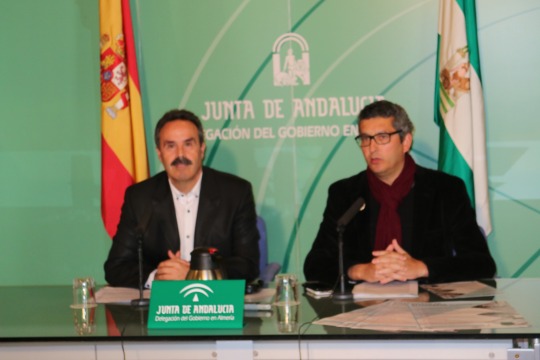
0 notes
Text
Entre las actividades lúdicas y culturales que ha elaborado el Conjunto Monumental de la Alcazaba de Almería para los próximos dos meses habrá visitas teatralizadas, temáticas, en clave de género, talleres para niños, charlas y conferencias sobre conservación del patrimonio alcazabeño y una jornada performativa enfocada en redes sociales y patrimonio cultural. Todo ello, alrededor de dos efemérides que marcan el calendario, el 28 de febrero, Día de Andalucía y el 8 de marzo, el Día de la Mujer. Gran parte de las actividades están destinadas al público familiar, a los más pequeños de la casa, y a los adultos, con la intención siempre de generar experiencias para mejorar, conservar, enseñar, proteger, valorar y respetar el patrimonio cultural.
Día de Andaluc
La Alcazaba ha preparado para el Día de Andalucía diferentes actividades para todos los públicos. Así, el sábado 23 de febrero tendrá lugar la visita teatralizada para público familiar ‘Una gozada de Alcazaba’,del grupo Viajar en el tiempo. Con ella, las familias con los pequeños de la casa se acercarán de forma dinámica, divertida y original a la historia de la Alcazaba y de Almería. Se pasearán por los rincones más emblemáticos del monumento y, personajes como Amina, Drisia, Baraka y Alí, habitantes de la fortaleza desde hace más de 1.000 años, serán los encargados de narrar los contenidos histórico-culturales.
El domingo 24 tendrá lugar la charla interdisciplinar La conservación del frente sur de la Alcazaba: patologías y restauraciones desde el siglo XX y XXI, a cargo de Pedro Gurriarán, arquitecto, Rosa Morales, arqueóloga, Cruz Ramos, restauradora y Arturo del Pino, director del Conjunto. La existencia de humedades en muchos de los paños de la Alcazaba ha llamado la atención de profesionales y personal de la administración desde hace tiempo. Proliferan especialmente en el frente meridional del monumento, y se manifiestan mediante la presencia de grandes manchas, distribuidas de forma aleatoria sobre los paramentos.
Por ello, desde el pasado mes de julio se están llevando a cabo diferentes trabajos en un lienzo de 12 metros, para intentar extraer conclusiones a la hora de conocer el origen y erradicar la presencia de humedades, de modo que puedan ser extrapoladas a otras zonas de la fortaleza. Para ello se han ejecutado trabajos arqueológicos en su trasdós, con objeto de verificar la presencia de redes de saneamiento enterradas o puntos de desagüe originales en la muralla. Igualmente, se pretendía conocer arqueológicamente el origen del paño y su evolución. Una vez realizada la intervención arqueológica se acometió un completo trabajo analítico de los materiales edilicios de la muralla a cargo de especialistas del Grupo de Investigación TEP-198 “Materiales y Construcción” adscrito al Dpto. de Construcciones Arquitectónicas II de la Universidad de Sevilla. En esta charla se hablará de alguna de sus claves.
El mismo jueves 28 de febrero, el Conjunto ha programado dos actividades, por un lado una visita interpretada para disfrutar de la naturaleza, la historia, la arqueología y de las inmejorables vistas sobre el mar y la ciudad de la mano de los Informadores Culturales; y otra, al Enclave arqueológico Puerta de Almería, donde el visitante podrá acercarse a los vestigios arqueológicos romanos conservados, una factoría de salazones, así como a una de las puertas de la muralla islámica que cerraba la ciudad por el sur.
Además, para el 1º de marzo, el Conjunto ofertará el taller para niños ‘Alicatando nuestras casas’, para edades entre 6 y 12 años. El taller tiene como objetivo conocer las viviendas islámicas, su forma, distribución, decoración y contenido. En él los pequeños decorarán las paredes de las Casas Árabes usando la técnica del alicatado. Para ello a los niños se les proporcionará el material necesario para llevar a cabo esta decoración. Esta actividad irá acompañada de explicaciones sencillas por parte de los técnicos, sobre materiales de construcción, espacios funcionales de la casa, actividad que se desarrollaba en ella, etc.
Día de la Mujer
El 8 de marzo se celebra el Día de la Mujer, y la Alcazaba desde hace tiempo viene apostando por su visita temática ‘[Re]encuentro con el pasado. Mujeres tras los muros de la Alcazaba’, un itinerario gratuito donde el contenido gira alrededor de las huellas femeninas conservadas a lo largo del tiempo en la Alcazaba. Muchas fueron las mujeres en al-Andalus que sobresalieron por su saber y sus obras a través de la poesía, la música, la epigrafía, …igualmente conocidas fueron sus intrigas palaciegas y sus hábiles movimientos políticos, siempre planeados y efectuados desde la sombra y tras los muros. Con esta visita se pretende poner en valor el legado conservado y poco reconocido de las mujeres que habitaron Almería entre los siglos X-XV, y cuyo recuerdo aún pervive en la Alcazaba. A través de esta iniciativa se ofrece la oportunidad al visitante de descubrir el monumento desde una perspectiva más igualitaria y justa.
La visita podrá realizarse en abierto los días 3 y 10 marzo a partir de las 12.30 horas, previa inscripción para mayores de 16 años. El día 7 de marzo se ofrecerá la misma al alumnado de 1º de bachillerato del IES. Alhamilla, y el 14 de febrero se ofrecerá a 33 mujeres del programa de TVE ‘7 días sin ellas’ que visitarán el monumento.
El domingo 10 de marzo, también se ha preparado un nuevo taller para niños titulado ‘El comercio en al-Mariyya’, un divertido juego de mesa donde los niños de 6 a 12 años conocerán cómo era el intercambio comercial de la época de al-Mariyya -cultura, mercancías, personas, … – y la importancia comercial de la ciudad andalusí.
Redes sociales y patrimonio cultural
Consciente de la importancia de la redes sociales como vehículo para acercar el patrimonio, el Conjunto Monumental dedica de manera pionera una jornada a Redes sociales y patrimonio cultural, donde se plantea como punto de partida para evaluar y construir nuevas narrativas en torno a la Alcazaba desde una visión sociodigital. La jornada, que tendrá lugar el sábado 16 de marzo a partir de las 10.30 de la mañana, está pensada para la comunidad tuitera y instagramers del Conjunto. En ella se intentará dar respuesta a preguntas como ¿qué papel juega la comunidad digital en la gestión del patrimonio de la Alcazaba? ¿Realmente existe una comunidad digital vinculada al patrimonio de la ciudad? ¿Cómo podemos introducir las redes sociales en las visitas guiadas tradicionales? ¿Deberían los gestores de patrimonio almeriense tener más presente estas estrategias de comunicación y a su comunidad digital? La inscripción y las bases de esta jornada que correrá a cargo de la museóloga Marian Alonso, se publicará en las redes del Conjunto en los próximos días.
Visitas temáticas
A lo largo de estos dos últimos años la Alcazaba ha ido elaborando visitas temáticas propias relacionadas con los contenidos del monumento. Así el 10 de febrero tendrá lugar ‘La mirada de Prieto-Moreno. Obras y restauraciones en la Alcazaba durante el siglo XX’. Se trata de una visita por la formulación teórica y la práctica restauradora del arquitecto Francisco Prieto-Moreno [1907-1985] que durante cerca de cuarenta años intervino mediante diferentes obras en la fisonomía actual de la Alcazaba. Un itinerario que recorre los primeros intentos de conservación del conjunto desde su declaración como Monumento Histórico Artístico en 1931 con la figura de Leopoldo Torres Balbás, para llegar al análisis concreto de Prieto-Moreno, como ejemplo representativo de las propuestas que marcaron la restauración monumental durante la inmediata posguerra y las siguientes décadas del siglo XX.
El 31 de marzo será el turno para la ruta ‘Alcazaba, patrimonio de cine’, una visita temática organizada por el Conjunto Monumental de la Alcazaba en colaboración con la asociación Almeríacine cuyo objetivo es dar a conocer el valor de este patrimonio como escenario cinematográfico en el rodaje de un total de 32 películas y series televisivas, algunas tan emblemáticas como Indiana Jones y la última cruzada, Juego de Tronos, Marchar o morir, Conan el Bárbaro, o recientemente, Wonder woman.
También, dentro de las estrategias de conservación de nuestro legado cultural, el domingo 17 de marzo a las 12.30, tendrá lugar la charla ‘Técnicas 3d en la restauración del patrimonio’, a cargo de Lola Miralles, Gerardo Úbeda, arquitectos, y César Ordás, restaurador. Y es que el tratamiento del patrimonio supone para los técnicos que trabajan en ello un enorme reto, puesto que tienen que elevar el nivel y profundizar en los detalles minimizando los errores y maximizando el conocimiento previo del entorno en el que trabajan. Las herramientas 3d disponibles hoy en día (scanners láser 3d, scanners led, fotogrametría, impresión 3d …) suponen un avance indiscutible en la forma en la que nos acercamos a estas intervenciones. Nada podrá jamás sustituir el conocimiento y la formación de los técnicos, pero sin duda, estas herramientas 3d sí que permiten trabajar con un grado de precisión milimétrico, permitiendo obtener resultados sorprendentes, estudiar piezas patrimoniales desde perspectivas inusuales y controlar la totalidad del proyecto desde los ordenadores.
Además, como viene siendo tradicional, todos los sábados del año el Conjunto ofrecerá visitas interpretadas al monumento a partir de las 12.00 horas bajo el título ¡Conoce tu Alcazaba!, donde los informadores del mismo acercarán éste de una manera distendida, pedagógica y gratuita a todos aquellos que quieran acercarse a ella.
Todas las actividades son gratuitas hasta completar el aforo. Para algunas de ellas es necesaria la reserva previa llamando al 600142982 de martes a domingo de 9.00 a 14.00 horas. Más información de las mismas a través de la página web o las redes sociales del Conjunto.
La Alcazaba centra su actividad de febrero y marzo en el Día de Andalucía, la mujer y el respeto al patrimonio cultural Entre las actividades lúdicas y culturales que ha elaborado el Conjunto Monumental de la Alcazaba de Almería para los próximos dos meses habrá visitas teatralizadas, temáticas, en clave de género, talleres para niños, charlas y conferencias sobre conservación del patrimonio alcazabeño y una jornada performativa enfocada en redes sociales y patrimonio cultural.
0 notes
Text
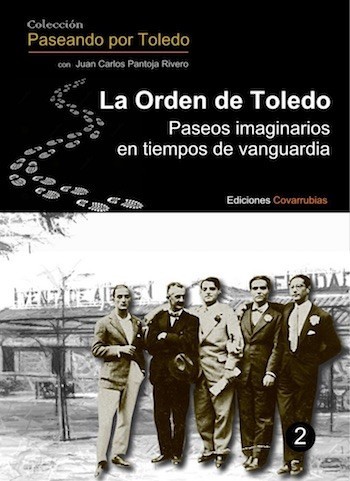


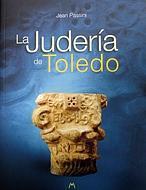
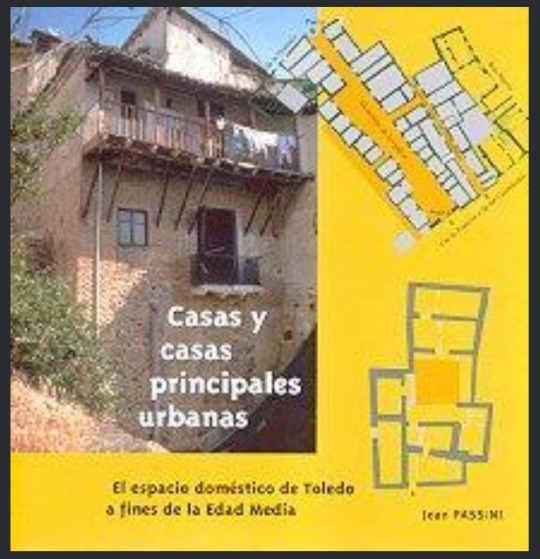


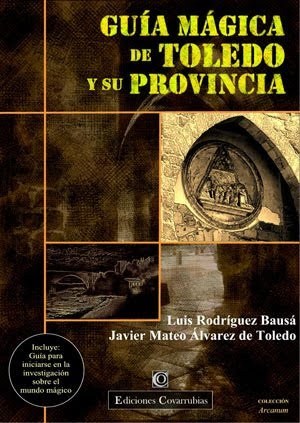


Propaganda
1. La Orden de Toledo: Paseos imaginarios en tiempos de vanguardia (The Order of Toledo: Imaginary walks in avant-garde times)
Author: Pantoja Rivero, Juan Carlos
Editorial: Covarrubias Ediciones
Edition: 2019
Synopsis: The Order of Toledo was, above all, an avant-garde fantasy of the brilliant film director Luis Buñuel, who knew how to infect his friends from the Generation of '27 to the Spanish intellectuality of the first third of the 20th century. Together, they dedicated themselves to living Toledo as if it were the great stage of a surrealist montage, in an artistic (or anti-artistic and irational) contrast with the monumentality and historical past of the old dead city.
(Well, in my blog I have been making posts about The Order of Toledo and the book is a valuable source)
2. Toledo: La ciudad de los muertos (Toledo: The city of the dead)
Author: Leblic García, Ventura
Editorial: Covarrubias Ediciones
Edition: 2013
Synopsis: Toledo. A large historical necropolis where Carpetans, Romans, Visigoths, Muslims, Jews and Christians rest...their rites around death, beliefs, customs, evolution of the cemetery spaces...
(I have posted the scans of the first pages of this books and I'm planning to keep on posting them but I wanted to know if you want scans from another book)
3. De Mayrit a Madrid: Madrid y los árabes del siglo IX al siglo XXI (From Mayrit to Madrid: Madrid and the Arabs from the 9th century to the 21st century)
Editors: Madrid. Casa Árabe e Instituto Internacional de Estudios Árabes y del Mundo Musulmán ; Barcelona ; Madrid: Lunwerg
Edition: 2011
Synopsis: This work deals with the Arab-Islamic past (Andalusian, Mudejar and Moorish) of Madrid and its forgotten heritage since it is the only European capital whose origins and name are linked to Arabic.
Revisiting that past and making it known is the objective of this work, which wants to rescue knowledge of a relationship between Madrid and the Arabs that does not end in the Middle Ages, since the town and court maintained various links with what was over time. Arab through diplomatic delegations, Arab figures welcomed by the city, valuable collections of manuscripts and numismatics, a romantic architectural taste that seeded the city with unique neo-Islamic buildings or Hispano-Arab scientific and cultural institutions. And, finally, the cosmopolitan and intercultural reconversion of the city has made it the recipient of a new Arab and Muslim immigration that once again gives human visibility to this relationship between Madrid and the Arab.
4. La Judería de Toledo (The Jewish Quarter of Toledo)
Author: Passini, Jean
Editorial: Ediciones del Sofer
Edition: 2014
Synopsis: The work reveals the vestiges of the areas of medieval Toledo Jewry and its history. It collects a topographical reading of its evolution and offers the main elements through maps, plans and high-quality color photographs.
5. Casas y casas principales urbanas : el espacio doméstico de Toledo a fines de la Edad Media (Houses and main urban houses: the domestic space of Toledo at the end of the Middle Ages)
Author: Passini, Jean.
Editor: Toledo. Universidad de Castilla-La Mancha
Edition: 2004
Synopsis: This work is an extension of previous research on different districts, and seeks, for the city as a whole, to “understand the genesis of medieval urban space, to follow its transformations and successive reappropriations” , mainly with the aim of understanding, for one of the ancient provincial capitals of al-Andalus, the modalities of the transition from the Muslim city of the end of the eleventh century (time of its occupation by the Christians) to the Castilian city of the end of the Middle Ages. The main documentary basis of the work is a very important and very detailed inventory of the real estate of the Cathedral Chapter, an inventory carried out in 1491-1492, which covers a considerable heritage of 557 various buildings located in 64 sites or districts. The identification and location of houses, shops, mesones or fondouks and other urban buildings, often difficult on the current plot, has however resulted in the careful study of more than half of these old buildings. The systematic comparison of the text from the end of the Middle Ages with the remains still visible above ground or underground (and this very meticulous and patient work in the cellars of current Toledan houses is one of the great originalities of the research of Jean Passini) gave the results which are presented in this latest publication.
6. España medieval : el origen de las ciudades (Medieval Spain: the origin of the cities)
Authors: Novoa Portela, Feliciano; Villalba Ruiz de Toledo, F. Javier
Editors: Barcelona ; Madrid : Lunwerg, D.L.
Edition: 2012
Synopsis: A fascinating essay that will teach us to look at and understand our cities better. In the pages of this essay we will analyze the Roman origins, the Islamic, Christian and European influences to discover the cultural melting pot that marks the Spanish urban legacy, without forgetting some disappeared cities that tell us their history through archaeological remains.
7. Valle-Inclán y el insólito caso del hombre con rayos x en los ojos
(Valle-Inclán and the unusual case of the man with x-rays in his eyes)
Editors: Madrid. La Felguera
Edition: 2014
Synopsis: In 1923, a piece of news sparked great controversy among intellectuals, journalists and scientists. Joaquín Argamasilla, a young descendant of a family of aristocrats, claimed to have x-ray vision that allowed him to see through opaque bodies. The controversy, which divided half the country between defenders and detractors of the strange case, reached the highest circles. In April, at the initiative of Queen María Cristina, a commission was established to study the case, chaired by Ramón y Cajal. Valle-Inclán came to Argamasilla's defense and the great Harry Houdini challenged him to a public demonstration in New York.
(Joaquín Argamasilla, Harry Houdini, Valle-Inclán, Ramón y Cajal... yep, we're thinking the same, episode 2xO6, Tiempo de Magia, from El Ministerio del Tiempo, if anyone wants to learn more about this topic this book is good)
8. Guía mágica de Toledo y su provincia (Magical guide to Toledo and its province)
Authors: Rodríguez Bausá, Luis; Álvarez de Toledo, Javier Mateo
Editorial: Ediciones Covarrubias
Edition: 2010
Synopsis: Saramago wrote that traveling should be a matter of another matter, staying more and walking less; and a little later he added that it is not good to stay for only a quarter of an hour next to a construction that is seven hundred years old. The authors agree with such appropriate phrases, and that is why they have written this route, this uneven guide, this compilation of events, in short, so that the traveler stops in a multitude of towns that only sounded like transit and never like stop and inn. Because the truth is that the city of Toledo and its province discreetly hide a large number of enclaves that deserve to be savored by the five senses, and in which one must rest until the memory is macerated. This is what this work talks about: caves, sacred mountains, magical wells, rainy images, enchanted fountains or thunderous miracles... but, above all, towns, cities and regions; yes, with order and a taste of dissidence and heterodoxy.
Also included is what the authors have called "Beginner's Guide", a brief but rigorous approach to the magical phenomenon, something like an index so that whoever wants it, has the basic premises to get started in the world of research on these issues.
9. AL-ANDALUS. Ocho siglos de civilización musulmana que marcaron la historia y la cultura de España (AL ANDALUS. Eight centuries of Muslim civilization that marked the history and culture of Spain)
Author: Masiá, Concha
Editorial: ALBA
Edition: 2006
Synopsis: "In the year 711, the Muslims arrived in the Iberian Peninsula. They called the vast territory where they settled for 800 years, from Tarifa to the Pyrenees, from the Levant to Portugal, al-Andalus. With their lights and shadows, these eight centuries of Muslim civilization, configuring many aspects of our personality as a people and as a culture, to which we Spaniards of the 21st century are still indebted"
This book and the following two books are like a triology about Al Andalus. This first one collects information about the different periods, states, events and some of its rulers throughout the history of Al Andalus.
10. AL-ANDALUS. Personajes históricos (AL ANDALUS. Historical figures)
Author: Masiá, Concha
Editorial: Albor Libros, Madrid
Edition: 2011
Synopsis: "A general vision of al-Andalus, from the 8th century to the 17th century, through its most prominent characters and also through less known, although no less important, people. Both of them reveal the splendor and glory of the imperishable Andalusian legacy"
This book gathers information about divers people from different states and periods throughout the history of Al Andalus: emirs, caliphs, politicians, religious leaders, warriors, scholars, artists, philosophers, poets...
11. AL-ANDALUS. 800 años de lucha (AL ANDALUS. 800 years of struggle)
Author: Masiá, Concha
Editorial: Albor Libros, Madrid
Edition: 2011
Synopsis: "In the year 711, the Muslims arrived in the Iberian Peninsula. They called the vast territory where they settled for 800 years, from Tarifa to the Pyrenees, from the Levant to Portugal, al-Andalus. With their lights and shadows, these eight centuries of Muslim civilization, configuring many aspects of our personality as a people and as a culture, to which we Spaniards of the 21st century are still indebted"
This book offers a view on the warfare, battles and military campaigns from different periods and states throughout the history of Al Andalus.
12. 20 grandes obras de 20 autores andalusíes (20 great works by 20 Andalusian authors)
Author: Lirola Delgado, Jorge
Editorial: FUNDACIÓN IBN TUFAYL DE ESTUDIOS ARABES
Edition: 2014
Synopsis: Selection of 20 Andalusian authors and 20 works from the different periods of al-Andalus. The book offers a biography of each author and a detailed description of the work.
#bookblr#books#history#polls#history books#spanish history#al andalus#la orden de toledo#paseos imaginarios en tiempos de vanguardia#toledo: la ciudad de los muertos#de mayrit a madrid#madrid y los árabes del siglo IX al siglo XXI#la judería de toledo#casas y casas principales urbanas#el espacio doméstico de Toledo a fines de la Edad Media#españa medieval : el origen de las ciudades#valle-inclán y el insólito caso del hombre con rayos x en los ojos#guía mágica de toledo y su provincia#AL-ANDALUS. Ocho siglos de civilización musulmana que marcaron la historia y la cultura de España#AL-ANDALUS. Personajes históricos#AL-ANDALUS. 800 años de lucha#20 grandes obras de 20 autores andalusíes#sefarad#madrid#toledo#the order of toledo#The Order of Toledo: Imaginary walks in avant-garde times#Toledo: The city of the dead#From Mayrit to Madrid#Madrid and the Arabs from the 9th century to the 21st century
9 notes
·
View notes
Text
As I promised, let's start with the bookscans:
Al-ANDALUS. PERSONAJES HISTÓRICOS
(Al Andalus. Historical figures)
Concepción Masiá
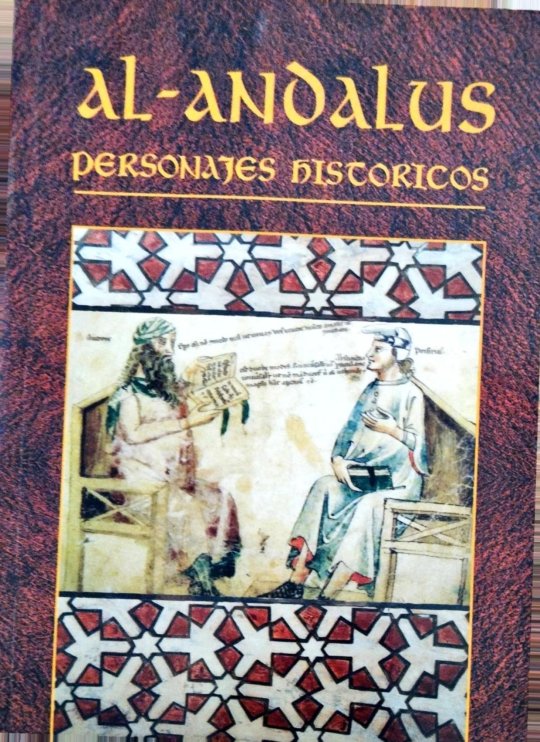
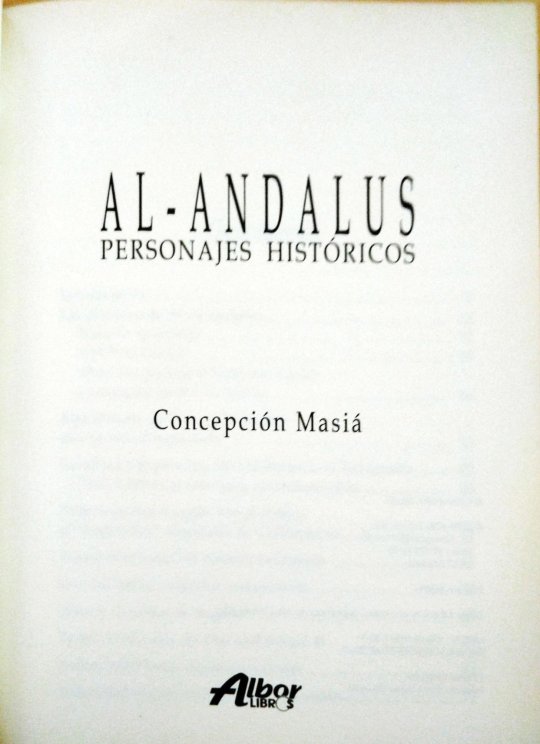

Summary
Introduction.................................. 9
The precursors of al-Andalus.....13
Count Don Julián....................13
Tarif ben Malluk. ....................15
Musa ben Nusayr and Tariq ben Ziyad: the conquerors of Spania...........16
Abd al-Aziz: a good governor with an unfortunate fate ..........................25
The Odyssey of Prince Abd al-Rahman the Immigrant......................................29
Abd al-Rahman was only twenty-five years old.........................................36
Sulayman ben Yaqzan ben al-Arabi: Charlemagne's deceived "deceiver" ........................... ...........41
Amrus ben Yusuf: the muladí of Huesca
.............................................................47
The “rabadies”: adventurous spirits.. ..............................................53
Ziryab: the singer of Baghdad........61
Tarub: the favorite of Abd al-Rahman II...............,...........................................67
Abbas ben Firnas: the first aviator............................ ......................73
Yahya ben Hakan al-Bakri: the miserly poet.....................................................77

Abd al Chabbar and Sulayman ben Martin: the rebels of Mérida..........................81
Eulogio and Álvaro de Córdoba:
pursuing martyrdom..........................85
The Andalusian Vikings..................... 95
The emir Abd Allah distrust and death...............................….................... 101
Musa ben Musa ben Qasi: the third king of Spain.......................................................107
Ibn Hafsun: the unredeemed rebel.....115
Abu Alí al-Sarrach: the Andalusian missionary. ...........................................125
Ibn Masarra: a freethinker in Spanish Islam.......,...........,...................................131
Abd al-Rahman III:
the first independent caliph of al-Andalus. ...........,................................137
Hasday ibn Shaprut:
the Jewish doctor of Abd al-Rahman III............ ....... ...................... ................... 145
Andalusians in France: the “Moorish kingdom” of Fraxinetum....................... 151
Rabbi ben Zayd: Bishop Recemundo............................................. 157
Al-Hakam al-Mustansir bi-llah:
passion for culture.................................. 161
Ibn Abd Rabbhi, the encyclopedist,
and Ibn Futais, the collector.................. 167
Al-Mansur “the Victorious” ...................171
Hisham II and Sanchuelo: misrule. .......191
Abu Muhammad Ali ibn Hazm:
The pigeon neackle................................209
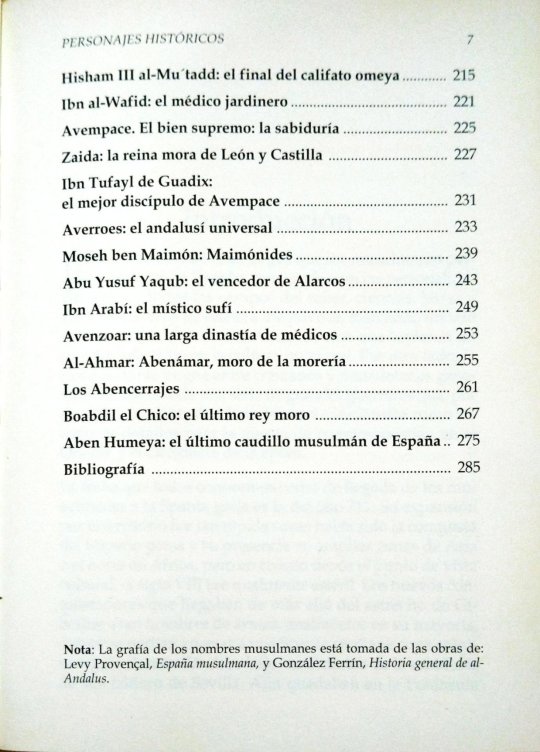
Hisham III al-Mu'tadd: the end of the Umayyad caliphate...............................215
Ibn al-Wafid: the gardener doctor.....221
Avempace. The supreme good: wisdom...................................................225
Zaida: the Moorish Queen of Leon and Castile........................................................227
Ibn Tufayl of Guadix:
the best disciple of Avempace................. ............................ .231
Averroes: the universal Andalusian....233
Moseh ben Maimon: Maimonides..... ..239
Abu Yusuf Yaqub: the winner of Alarcos......................................................243
Ibn Arabi: the Sufi mystic.....................249
Avenzoar: a long dynasty of doctors. ...................................................253
Al-Ahmar: Abenámar, Moor of the Morería. ...,...............................................255
The Abencerrajes. ..................................261
Boabdil the Younger: the last Moorish king ............................................................267
Aben Humeya: the last Muslim leader of Spain................ ..........................................275
Bibliography .............................................285
Note: The spelling of Muslim names is taken from the works of: Levy Provençal,
Muslim Spain, and González Ferrín, General History of al-Andalus.

Introduction
In the long eight hundred years that the Muslims remained in Spain, there were many personalities who, in all the fields of knowledge, sciences, letters and arts, stood out unequivocal, marking a milestone not only in the culture of al-Andalus, but that had a relevant character in universal culture.
On the other hand, the almost constant struggle between Christians and Muslims would also generate a whole series of great warriors who, for example, the infante Don Juan Manuel considered the best gifted for the war of all those who existed in the East and the West of their time.
The date that we all know as the arrival of the Muslims to Gothic Spania dates back to the year 711. Its expansion throughout the territory was so rapid as had been the conquest of the Persian empire and its presencein large areas of Asia or North Africa, but from a cultural point of view, the 8th century was totally sterile. The new conquerors who arrived from beyond the Strait of Gibraltar, were men at arms, mostly illiterate, who could do little contribute to a Christian Spania whose culture continued to develop under the dictates of the wisdom of Saint Isidore of Seville. Still they were left on the Peninsula
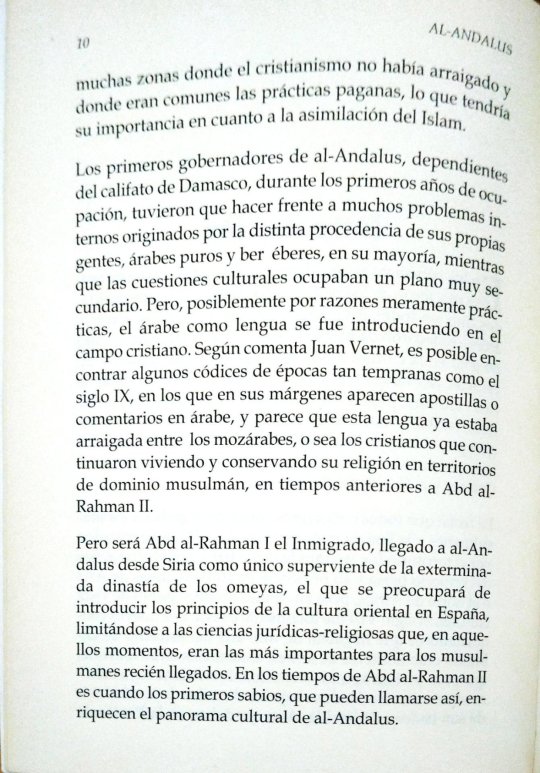
many areas where Christianity had not taken root and its importance regarding the assimilation of Islam.
The first governors of al-Andalus, dependent on Caliphate of Damascus, during the first years of occupation
had to face many enormous internal problems, originated by the different origins of their own people, Arabs
and berebers, mostly, while cultural issues occupied a very secondary level. But, possibly for purely practical reasons, Arabic as a language was introduced into the Christian field. According to Juan Vernet, it is possible to find
some codices from times as early as the 9th century, that in its margins appear apostilles or comments in Arabic,
and it seems that this language was already rooted among the Mozarabs,
that is, the Christians who continued to live and preserve their religion in Muslim-dominated territories, in times
before Abd al-Rahman II.
But it will be Abd al-Rahman I the Immigrant, who arrived in al-Andalus from Syria as the only survivor of the exterminated Umayyad dynasty, the one who will be concerned with introducing the principles of oriental culture in
Spain, limiting itself to the legal-religious sciences that, in those moments, were the most important for the newly Muslims
arrived. It was during the time of Abd al-Rahman II that the first wise men, who can be called that, enrich the cultural landscape of al-Andalus.

Poets, doctors, philosophers, mathematicians, geographers, undefeated generals...All of them will give al-Andalus and Europe a series of works that, by their importance will be translated, searched, accepted and will serve as a basis for the western culture and Renaissance ideas, in such a way that many of the great sages of the Italian Renaissance considered that all knowledge of the time came from Muslim Spain, which all the wise men were of Andalusian origin. And when the political decline and the disintegration of the caliphate, will not stop birth, grow and develop distinguished minds that will continue to maintain,for a long time, the prestige of al-Andalus. Curiously, this situation will be repeated throughout the history of Spain, when the Arab occupation just be a memory. The Spanish Golden Age will coincide with decadence of the Austrias, when the country loses its pre-ponderance in Europe, and with the disaster of '98, with the loss for Spain of its last colonies, will produce a cultural and scientific renaissance that has been called the Silver age.
Through the pages of this book we want to highlight those figures who occupied a predominant place in the history of al-Andalus, although not all of them were necessarily Muslims, since that in that cultured and tolerant al-Andalus, many Jews and some other Christians showed their genius, and of those who, often, we know more about his works than about his biography. But whatever religion they had, they were all, after all, Andalusians, born and raised in the extensive lands of al-Andalus. As a matter of curiosity we will include some groups of characters
anonymous people who, due to their surprising
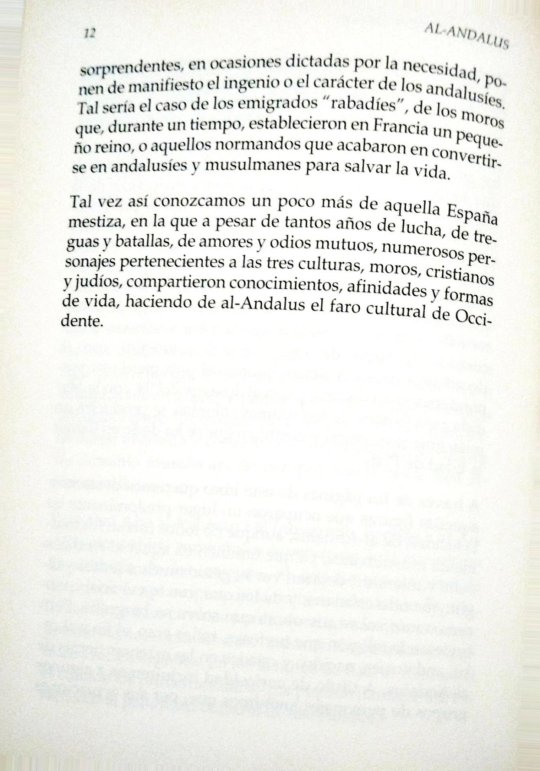
actions, on occasions dictated by necessity, they reveal the ingenuity or character of the Andalusians. Such would be the case of the "rabadíes", of the Moors who, for a time, established a small kingdom in France, or those Normans who ended up becoming Andalusians and Muslims to save their lives.
Perhaps this way we will learn a little more about that crossbred Spain, in which despite so many years of struggle, truces and battles, mutual loves and hates, numerous characters belonging to the three cultures, Moors, Christians and Jews shared knowledge, affinities and forms of
life, making al-Andalus the cultural beacon of the West.

The precursors of al-Andalus
Count Don Julián
The conquest of Morocco had been carried out quickly, but shallow. The Berbers were only subdued after a fierce resistance, defeated by an ambitious general who had just been appointed governor of Ifriqiya and Maghrib. His successes in these lands
They would prepare the ground for him to be the one to set his eyes and, also
his troops, over Gothic Spania. It was Musa ben Nusayr.
Musa, with the help of one of his sons, took possession of Tangier, and demanded that the subjugated tribes hostage to educate them in the new faith, which in turn, became propagandists of Islam, leaving in the conquered Morocco
Arab lieutenants, including General Tariq ben Ziyad, he turned to Ifriqiya. But it seems that the Ceuta square remained
in the hands of a Christian, the so-called Count Don Julián, who would have a
determining role in this entire story. We could consider it as a precursor of that al-Andalus that was about to be born.
#bookblr#book scans#historyblr#history books#al andalus#al andalus. personajes históricos#al andalus. historical figures#history#spanish history#musa ibn nusayr#tariq ibn ziyad#conde don julián#count don julián#count julian
26 notes
·
View notes
Text
9th part of the bookscans of Al Andalus. Historical Figures, here's the previous part
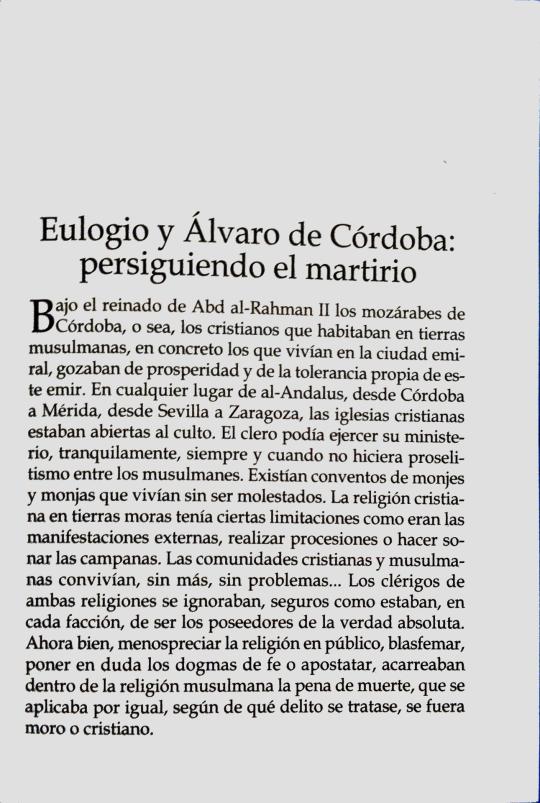
Eulogio and Álvaro de Córdoba:
pursuing martyrdom
Under the reign of Abd al-Rahman II the Mozarabs of Córdoba, that is, the
Christians who lived in Muslim lands, specifically those who lived in the emiral city, enjoyed prosperity and the tolerance typical of this emir. Anywhere in al-Andalus, from Córdoba to Mérida, from Seville to Zaragoza, the Christian churches were open for worship. The clergy could exercise his ministry, quietly, as long as he did not proselytize among the Muslims. There were convents of monks and nuns who lived without being bothered The Christian religion in Moorish lands had certain limitations such as the external manifestations, carrying out processions or ringing the bells. The Christian and Muslim communities lived together, without further ado, without problems... The clerics of both religions ignored each other, sure as were, in each faction, to be the possessors of the absolute truth. Now
well, belittling religion in public, blaspheming, questioning dogmas
of faith or apostatizing, carried within the Muslim religion the penalty of death, which was applied equally, depending on what crime it was, whether if the person was Moor or Christian.
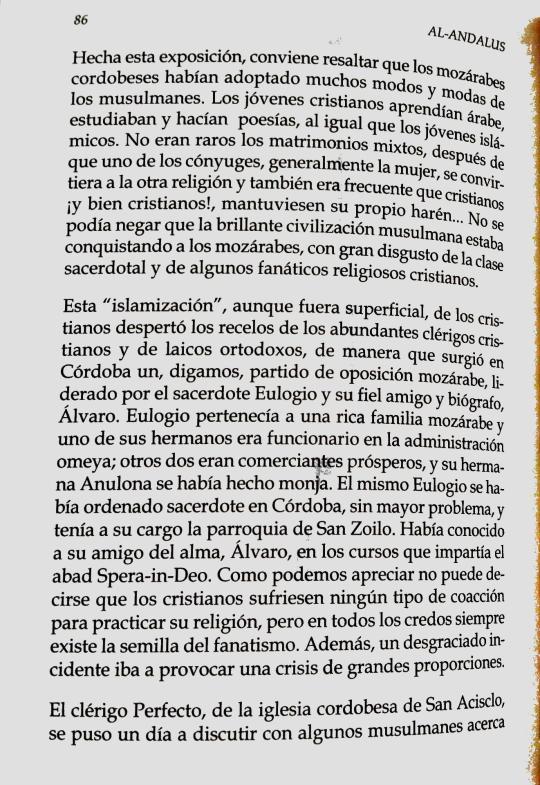
Having made this exposition, it is worth highlighting that the Mozarabs of Cordoba
had adopted many ways and fashions of the Muslims. Young Christians learned Arabic, studied and wrote poetry, just like the Islamic youth. Mixed marriages were not uncommon, after one of the spouses, usually the woman, converts to the other religion and it was also common for Christians, and very Christians, to maintain their own harem... It could not be denied that the brilliant Muslim civilization
was conquering the Mozarabs, to the great displeasure of the priesthood class and some Christian religious fanatics.
This "Islamization", even if it was superficial, of the Christians aroused the
suspicions of the abundant Christian clerics and Orthodox laymen, of way that a, let's say, Mozarabic opposition party emerged in Córdoba, led by the priest Eulogio and his faithful friend and biographer, Álvaro. Eulogio belonged to a rich Mozarabic family and one of his brothers was official in the Umayyad administration; two others were merchants
prosperous, and his sister Anulona had become a nun. Eulogius himself
had been ordained a priest in Córdoba, without much problem, and had his
charge of the parish of San Zoilo. He had met his soul friend, Alvaro in the courses taught by Abbot Spera-in-Deo. As we can see, It can be not said that Christians suffered type of coercion to practice their religion, but in all faiths there is always the seed of fanaticism. Furthermore, an unfortunate incident was going to cause a crisis of great proportions.
The clergyman Perfecto, from the Cordoban church of San Acisclo, one day began to argue with some Muslims about
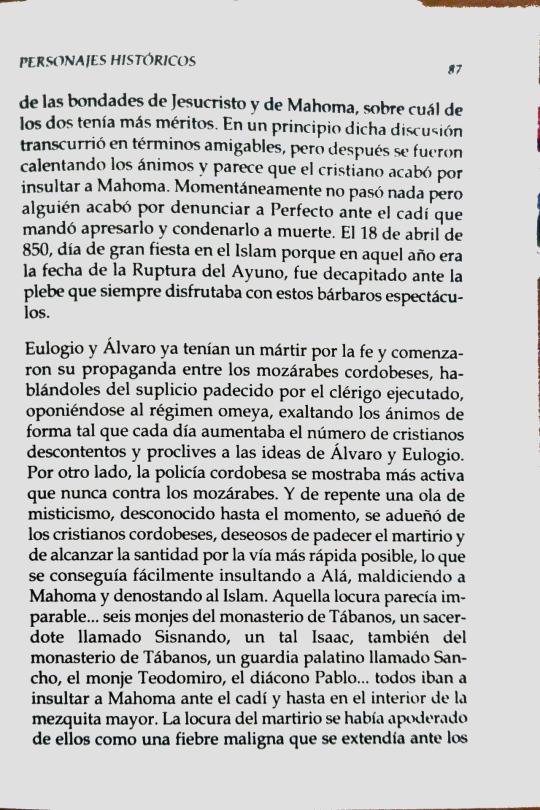
of the goodness of Jesus Christ and Muhammad, about which of the two had more merits. At first the discussion was on friendly terms, but later tempers were heating up and it seems that the Christian ended up insulting Muhammad. Momentarily nothing happened but someone ended up reporting Perfecto to the the cadi who ordered him to be arrested and sentenced to death. On April 18, 850, day of great holiday in Islam because that year was the date of the Breaking of the Fast, it was beheaded before the plebs who always enjoyed these barbaric spectacles.
Eulogio and Álvaro already had a martyr for the faith and began their propaganda among the Mozarabs of Cordoba, telling them about the torture suffered by the clergyman executed, opposing the Umayyad regime, raising spirits in such a way that every day the number of discontented Christians inclined to the ideas of Álvaro and Eulogio. On the other hand, the Córdoba police were more active than never against the Mozarabs. And suddenly a wave of mysticism, unknown until moment, took over the Christians of Cordoba, eager to suffer the martyrdom and achieving sainthood in the quickest way possible, which was achieved
easily insulting Allah, cursing Muhammad and reviling Islam. That madness seemed unstoppable...six monks from the Tábanos monastery, a priest named Sisnando, a certain Isaac, also from the Tábanos monastery, a guard palatine named Sancho, the monk Teodomiro, the deacon Pablo... they all went to insulting Muhammad before the qadi and even inside the main mosque. The madness
of martyrdom had taken hold of them like a malignant fever that spread before the
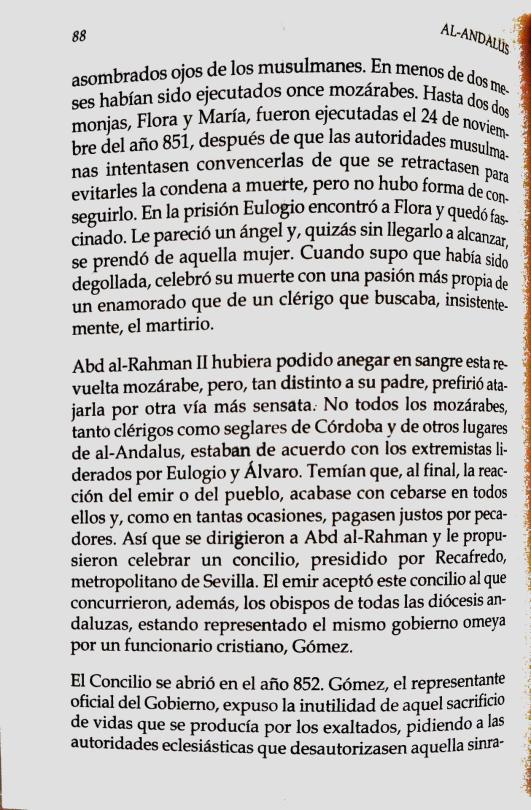
amazed eyes of the Muslims. In less than two months they had been eleven Mozarabs executed. Even two nuns, Flora and María, were executed on November 24, 851, after the Muslim authorities tried to convince them to recant to avoid the death sentence, but there was no way to achieve it. In prison Eulogio found Flora and was fascinated. It seemed like a
angel and, perhaps without reaching him, he fell in love with that woman. When
knew that she had been beheaded, he celebrated her death with a greater passion typical of a lover than of a clergyman who was insistently seeking,
the martyrdom.
Abd al-Rahman II could have drowned this revolt in Mozarabic blood, but, so different from his father, he preferred to tackle it by another sensiblebway. Not all the Mozarabs, both clerics and laymen of Córdoba and from other places in al-Andalus, agreed with the extremists
led by Eulogio and Álvaro. They feared that, in the end, the emir's reaction
or the town, ended up attacking all of them and, as in so many sometimes, the righteous paid for sinners. So they approached Abd al-Rahman and proposed holding a council, presided over by
Recafredo, metropolitan of Seville. The emir accepted this council to which, in addition, the bishops of all the Andalusian dioceses attended, the Umayyad government itself being represented by a Christian official, Gómez.
The Council opened in the year 852. Gómez, the official representative of the
Government, exposed the futility of that sacrifice of lives that occurred
by the exalted, asking the ecclesiastical authorities to disavow that non-
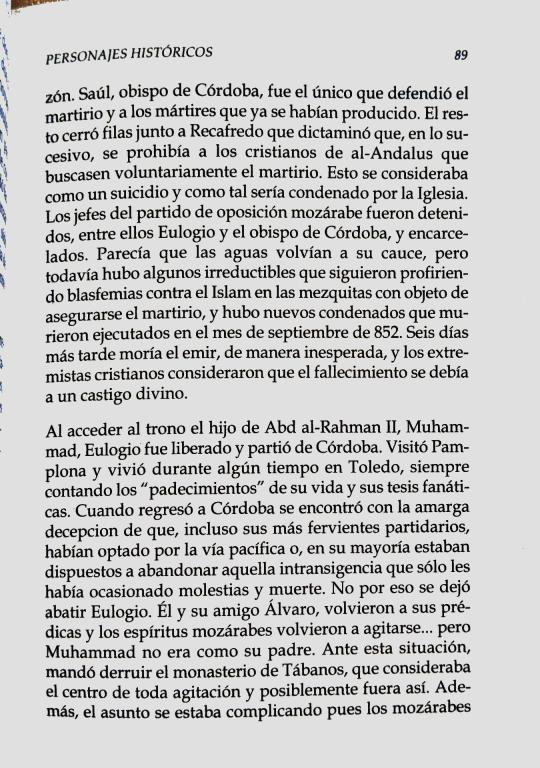
sense. Saúl, bishop of Córdoba, was the only one who defended martyrdom and the martyrs that had already occurred. The rest closed ranks with Recafredo who
ruled that, from now on, the Christians of al-Andalus were prohibited from
voluntarily seek martyrdom. This was considered suicide and
as such he would be condemned by the Church. The leaders of the Mozarabic opposition party were arrested, among them Eulogio and the bishop of Córdoba, and imprisoned. It seemed that the waters were returning to their channel, but there was still some irreducibles who continued uttering blasphemies against Islam in the
mosques in order to ensure martyrdom, and there were new convicts who were executed in the month of September 852. Six days later the emir died, unexpectedly, and the Christian extremists considered that the death was due to divine punishment.
When Abd al-Rahman II's son, Muhammad, acceded to the throne, Eulogius was released and left Córdoba. He visited Pamplona and lived for some time in Toledo, always recounting the "sufferings" of his life and his fanatical theses. When he returned to Córdoba he was met with the bitter disappointment that, even his most fervent supporters had opted for the peaceful route or, for the most part, were willing to abandon that intransigence that had only caused inconvenience and death. That's not why Eulogio let himself be discouraged. Him and his friend Álvaro, they returned to their preachings and the Mozarabic spirits stirred again... but Muhammad was not like his father. Faced with this situation, he ordered the demolition of the Tábanos monastery, which he considered the center of all unrest and possibly it was like that. Furthermore, the matter was becoming complicated because the Toledoan
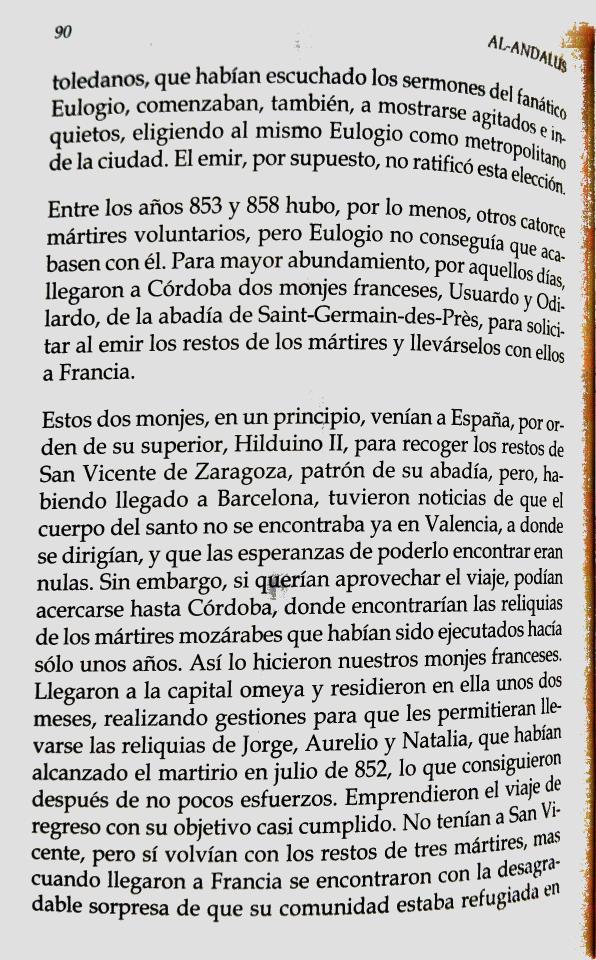
Mozarabs who had listened to the sermons of the fanatic Eulogio, were also beginning to appear agitated and restless, choosing Eulogio as metropolitan of the city. The emir, of course, did not ratified this election.
Between the years 853 and 858 there were at least fourteen other martyrs volunteers, but Eulogio couldn't get them to finish him off. For more abundance, in those days, two French monks arrived in Córdoba,
Usuard and Odilard, from the abbey of Saint-Germain-des-Près, to request the remains of the martyrs from the emir and take them with them to France.
These two monks, at first, came to Spain, by order of their superior, Hildouin II, to collect the remains of S. Vicente de Zaragoza, patron of his abbey, but, having arrived in Barcelona, they had news
that the saint's body was no longer in Valencia, where it was led, and that the hopes of being able to find him were zero.
However, if they wanted to take advantage of the trip, they could go to Córdoba,
where they found the relics of the Mozarabic martyrs who had been
executed only a few years ago. This is what our French monks did. They arrived in the Umayyad capital and lived there for about two months, taking steps to allow them to take the relics of Jorge, Aurelio and Natalia, who had achieved martyrdom in July 852, what they achieved after quite a bit of effort. They started the journey
back with his goal almost accomplished. They did not have S. Vicente, but they did returned with the remains of three martyrs, but when they arrived in France they found themselves with the unpleasant surprise that their community was
refugee in
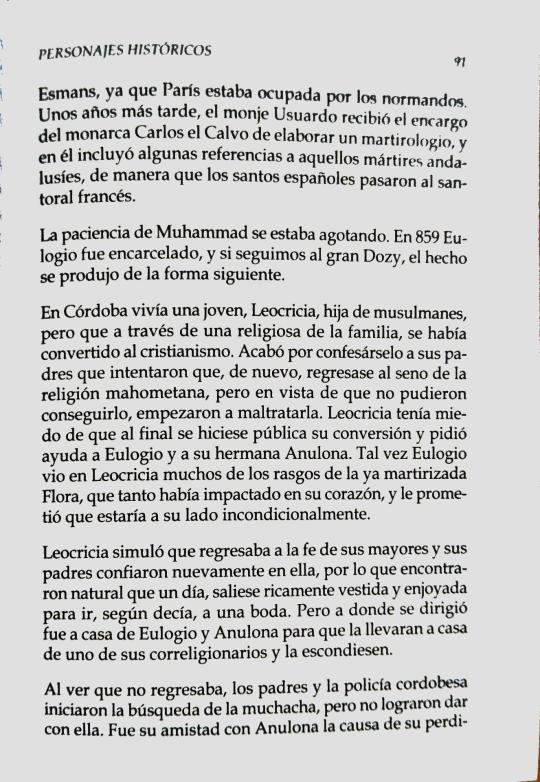
Esmans, since Paris was occupied by the Normans. A few years later, the monk Usuard received the commission from the monarch Charles the Bald to prepare a
martyrology, and in it he included some references to those Andalusian martyrs,
so that the Spanish saints passed to the French saints.
Muhammad's patience was wearing thin. In 859 Eulogio was imprisoned, and if we follow the great Dozy, the event occurred in the following way.
In Córdoba there lived a young woman, Leocricia, daughter of Muslims, but through a nun in the family, had converted to Christianity. She ended up confessing it to his parents who tried to get her to return to the bosom of the Mohammedan religion, but since they could not obtain it,
they began to mistreat her. Leocricia was afraid that in the end her conversion would become public and asked Eulogio and his sister Anulona for help. Maybe Eulogio saw
in Leocricia many of the traits of the already martyred Flora, who had so much
shocked in his heart, and he promised that he would be by his side unconditionally.
Leocricia pretended to return to the faith of her elders and her parents trusted
again in it, so they found it natural that one day, it would come out richly dressed and jeweled to go, as she said, to a wedding. But where she went to Eulogio and Anulona's house so they could take her to the house of one of her coreligionists and hid her.
Seeing that she did not return, the parents and the Córdoba police began the search
of the girl, but they could not find her. It was his friendship with Anulona that
cause of her perdi-
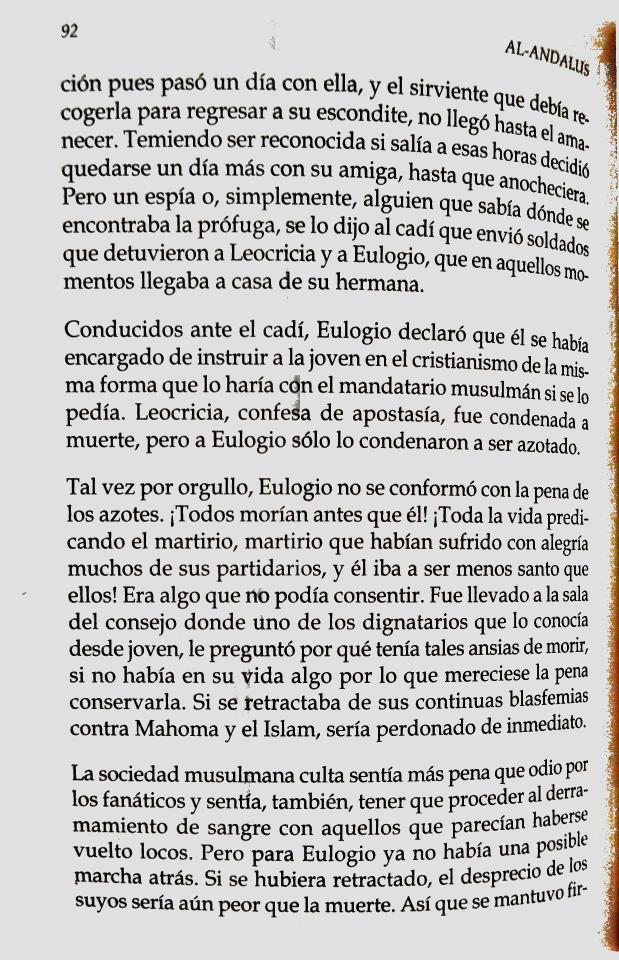
tion because she spent a day with her, and the servant who was to pick her up to
return to her hiding place, she did not arrive until dawn. Fearing to be recognized if she went out at that time, she decided to stay one more day with her friend, until nightfall. But a spy or simply someone who knew where the fugitive was, told the cadi who sent soldiers to arrest Leocricia and Eulogio, who at that time was reaching
his sister's house.
Brought before the cadi, Eulogio declared that he had taken care of instruct the young woman in Christianity in the same way as he would with the Muslim leader if he asked. Leocricia, confessed of apostasy,
was sentenced to death, but Eulogio was only sentenced to be whipped.
Perhaps out of pride, Eulogio did not settle for the punishment of whipping. Everyone died before him! All his life preaching martyrdom, martyrdom that many of his supporters had suffered with joy, and he
I was going to be less holy than them! It was something he couldn't consent. He was taken to the council room where one of the dignitaries who knew him since he was young, he asked him why he had such a desire to die, if there was no something in his life worth keeping. If he retracted
of his continued blasphemies against Muhammad and Islam, he would be forgiven immediately.
The cultured Muslim society felt more pity than hatred for the fanatics and they also felt that they had to proceed to shed blood with those who seemed to have gone crazy. But for Eulogio there was no longer a possible retreat. If he had retracted, the contempt of his people would be even worse than death. So he stood firm
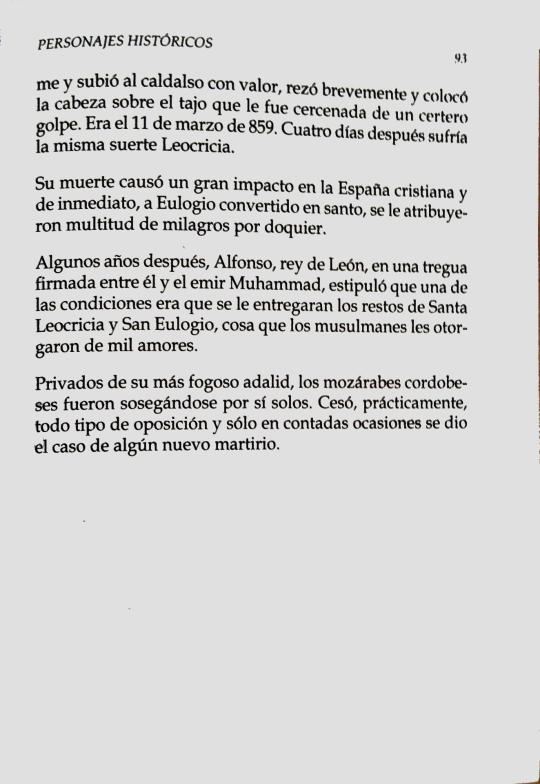
and he bravely climbed into the scaffold, prayed briefly and placed his head on the
slash that was severed with a well-aimed blow. It was March 11, 859. Four days later Leocricia suffered the same fate.
His death caused a great impact in Christian Spain and immediately,
Eulogio became a saint, a multitude of miracles were attributed to him
everywhere.
Some years later, Alfonso, king of León, in a truce signed between him and the emir Muhammad, stipulated that one of the conditions was that the remains of S. Leocricia and S. Eulogio would be handed over, something that Muslims gave them a thousand loves.
Deprived of their most fiery champion, the Mozarabs of Córdoba were calming down on their own. Practically all types of opposition ceased and only on rare occasions there was the case of a new martyrdom.
#al andalus. historical figures#al andalus. personajes históricos#al andalus#book scans#al andalus history#bookblr#historyblr#spanish history#emirate of cordoba#eulogio de córdoba#álvaro de córdoba#emirato de córdoba
14 notes
·
View notes
Text
12th part of the bookscans of Al Andalus. Historical Figures, here's the previous part
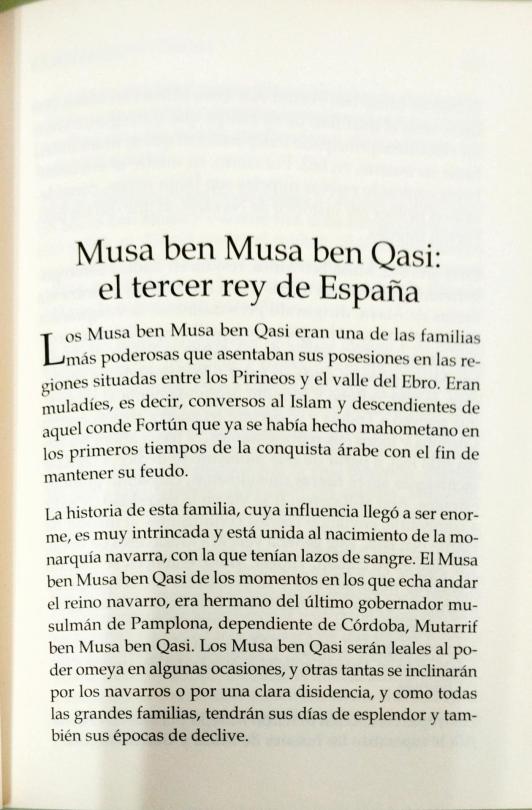
Musa ben Musa ben Qasi:
the third king of Spain
The Qasi were one of the most powerful families that established their possessions in the regions located between the Pyrenees and the valley of the
Ebro. They were muladíes, that is, converts to Islam and descendants of that count
Fortún who had already become a Mohammedan in the early days of the Arab conquest in order to maintain his fiefdom.
The history of this family, whose influence became enormous, is very intricate and
it is linked to the birth of the Navarrese monarchy, with which they had blood ties. The Musa ben Musa ben Qasi of the moments in which the Navarrese kingdom begins to move , he was brother of the last Muslim governor of Pamplona, dependent
of Córdoba, Mutarrif ben Musa ben Qasi. The Qasis will be loyal to the Umayyad power on some occasions, and on many other occasions they will lean towards the Navarrese or a clear dissidence, and like all great families, they will have their days of splendor and also its times of decline.
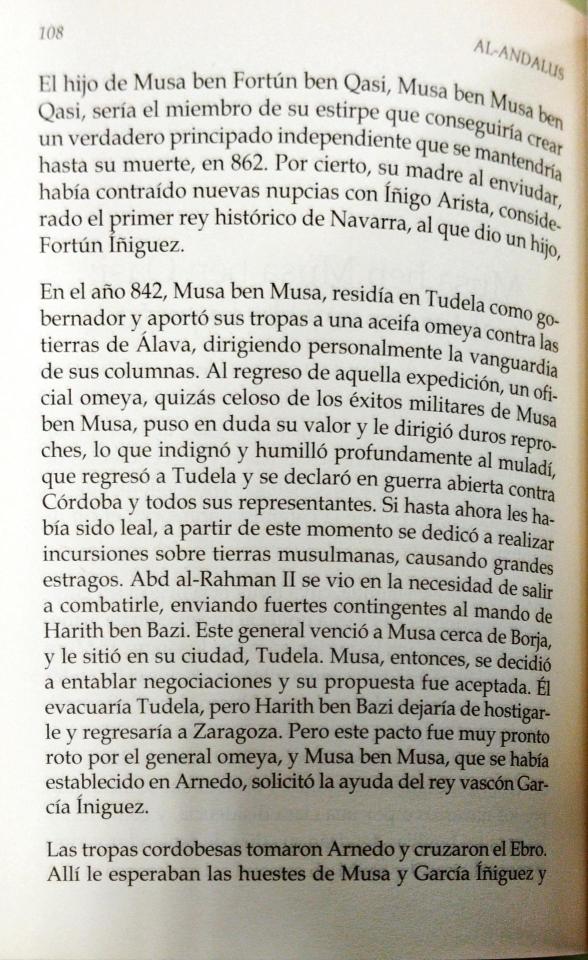
The son of Musa ben Fortún ben Qasi, Musa ben Musa ben Qasi, would be the
member of his lineage who would create a true independent principality that would remain until his death, in 862. By the way, when his mother was widowed, she had remarried with Eneko Aritza, considered the first historical king of Navarra, to whom she gave a son, Fortún Íñiguez.
In the year 842, Musa ben Musa, resided in Tudela as governor and contributed his troops to an Umayyad olive tree against the lands of Álava, directing personally the vanguard of his columns. Upon return from that expedition, an Umayyad officer, perhaps jealous of the military successes of Musa ben Musa questioned his courage and reproached him harshly, which outraged and deeply humiliated the muladí, who returned to Tudela and declared opened war against Córdoba and all its representatives. If until now there had been loyal, from this moment on he dedicated himself to carrying out raids on Muslims lands, causing great havoc. Abd al-Rahman II was seen in the need to go out to fight him, sending strong contingents under the command of
Harith ben Bazi. This general defeated Musa near Borja, and besieged him in his
city, Tudela. Musa then decided to start negotiations and his proposal was accepted. He would evacuate Tudela, but Harith ben Bazi would stop harass him and he would return to Zaragoza. But this pact was soon broken by the Umayyad general, and Musa ben Musa, who had settled in Arnedo, requested the help of the Basque king García Íniguez.
The Cordoban troops took Arnedo and crossed the Ebro. There the soldiers were waiting for the hosts of Musa and García Íñiguez and
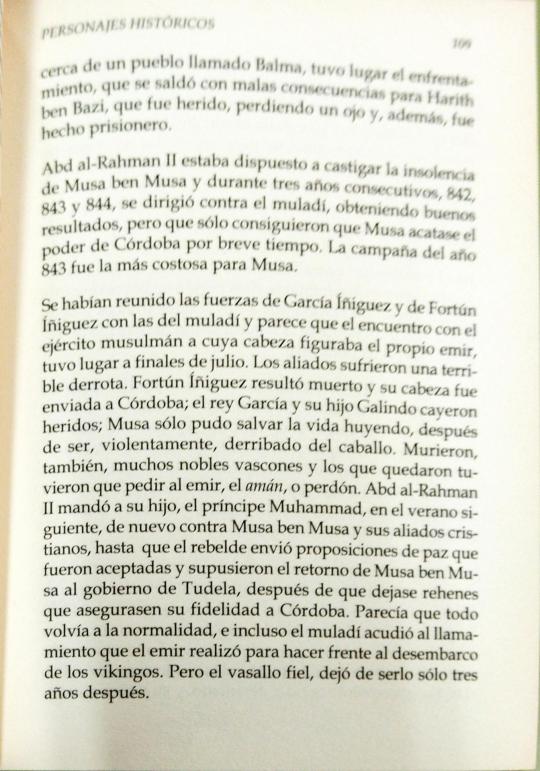
near a town called Balma, the confrontation took place, which ended with bad consequences for Harith ben Bazi, who was wounded, losing an eye and,
furthermore, he was taken prisoner.
Abd al-Rahman II was ready to punish the insolence of Musa ben Musa and
for three consecutive years, 842, 843 and 844, he went against the muladí,
obtaining good results, but they only managed to get Musa to comply with the
power of Córdoba for a short time. The campaign of the year 843 was the most costly for Musa.
The forces of García Íñiguez and Fortún Íñiguez had met with those of the
muladí and it seems that the encounter with the Muslim army whose head was
the emir himself, took place at the end of July. The allies suffered a terrible
defeat. Fortún Íñiguez was killed and his head was sent to Córdoba; the king
García and his son Galindo were wounded; Musa could only save his life by fleeing,
after being violently knocked off his horse. Many also died. Basque nobles and those who remained had to ask the emir, the haman, for forgiveness. Abd al-Rahman II sent his son, Prince Muhammad, in the following summer, again against Musa ben Musa and his Christian allies, until the rebel
sent peace proposals that were accepted and led to the return of Musa ben Musa to the government of Tudela, after he left hostages who ensured their loyalty to Córdoba. It seemed that everything was returning to normal, and even the muladí responded to the call that the emir made to face the landing of the Vikings. But the faithful vassal ceased to be so for only three years after.
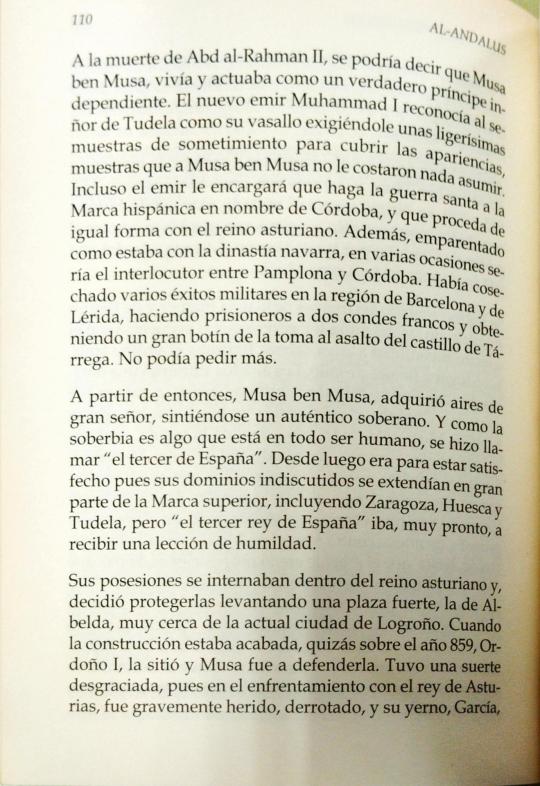
At the death of Abd al-Rahman II, it could be said that Musa ben Musa lived and
acted like a true independent prince. The new emir Muhammad I recognized the lord of Tudela as his vassal, demanding some very light signs of submission to cover appearances, signs that Musa ben Musa's benefits did not cost him anything to assume. Even the emir will commission him to wage holy war to the Hispanic March in the name of Córdoba, and to proceed in the same way with the Asturian kingdom. Furthermore, related as he was to the Navarrese dynasty, on several occasions he would be the interlocutor between Pamplona and Córdoba. He had achieved several military successes in the region of Barcelona and Lérida, making
taking two Frankish counts prisoners and obtaining great loot from the assault
of the Tárrega castle. He couldn't ask for more.
From then on, Musa ben Musa acquired the air of a great lord, feeling like a
authentic sovereign. And since pride is something that is in every human being, he is called "the third of Spain". Of course it was to be satisfied because his undisputed dominions extended over much of the Upper March, including Zaragoza, Huesca and Tudela, but "the third king of Spain" was going, very soon, to receive a lesson in humility.
His possessions were located within the Asturian kingdom and he decided to protect them, building a stronghold, that of Albelda, very close to the current city of
Logroño. When the construction was finished, perhaps around the year 859, Ordoño I, besieged it and Musa went to defend it. He had unfortunate luck, because inbconfrontation with the king of Asturias, he was seriously wounded, defeated, and his son-in-law, Garcia,
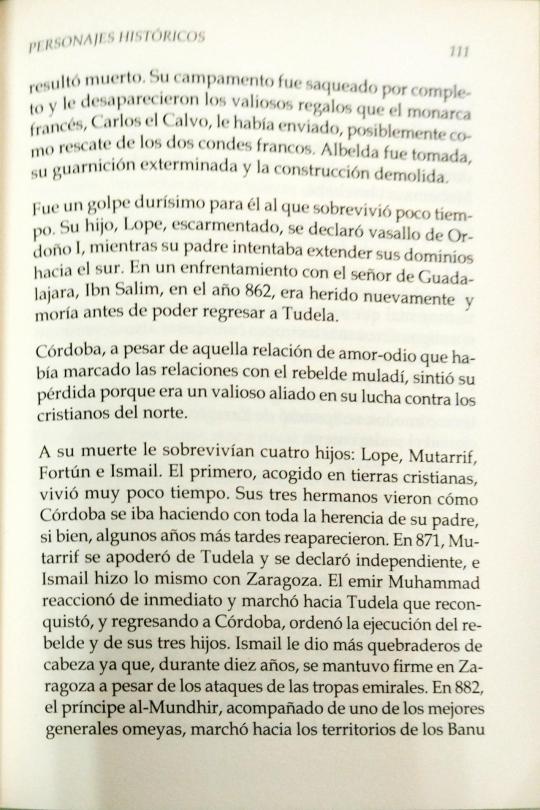
was killed. His camp was completely looted and the valuable gifts that the French monarch, Charles the Bald, had sent him disappeared, possibly as a ransom for the two Frankish counts. Albelda was taken, its garrison exterminated and construction demolished.
It was a very hard blow for him that he survived for a short time. His son, Lope,
chastened, he declared himself a vassal of Ordoño l, while his father tried
extend their domains to the south. In a confrontation with the lord of Guadalajara, Ibn Salim, in the year 862, he was wounded again and died before he could
return to Tudela.
Córdoba, despite that love-hate relationship that had marked the relations with the muladí rebel, he felt his loss because he was a valuable ally in his fight against the Christians of the north.
At his death he was survived by four children: Lope, Mutarrif, Fortún and Ismail. First, welcomed to Christian lands, he lived for a very short time. His three brothers saw how Córdoba was taking over his father's entire inheritance, although a few more years afternoons they reappeared. In 871, Mutarrif seized Tudela and declared himself independent, and Ismail did the same with Zaragoza. Emir Muhammad reacted immediately and marched towards Tudela which he reconquered, and returning to Córdoba, he ordered the execution of the rebel and his three sons. Ismail gave him more headaches since, for ten years, he stood firm in Zaragoza despite the attacks by emiral troops. In 882, prince al-Mundhir, accompanied by one of the best Umayyad generals, marched towards the territories of the Banu
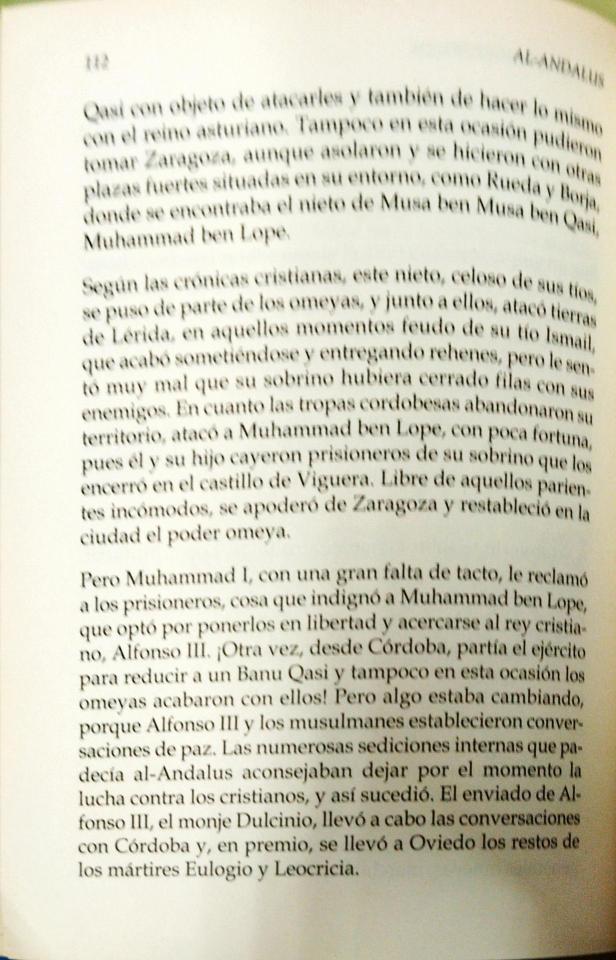
Qasi in order to attack them and also to do the same with the Asturian kingdom. Neither on this occasion could they take Zaragoza, although devastated other places located in their surroundings, such as Rueda and Borja, where Musa ben Musa ben Qasi's grandson is found, Muhammad ben Lope.
According to Christian chronicles, this grandson, jealous of his uncles, took side with the Umayyads, and together with them, he attacked the lands of Lleida, at that time a fiefdom of his uncle lsmail, who ended up submitting and handing over hostages, but he disliked that his nephew had closed ranks with his enemies. As for the Cordoban troops abandoned their territory, attacked Muhammad ben Lope,
with little luck, since he and his son fell prisoners of his nephew who confine them in the castle of Viguera. Free from those uncomfortable relatives, he seized Zaragoza and reestablished Umayyad power in the city.
But Muhammad I, with great lack of tact, demanded of the prisoners, something that outraged Muhammad ben Lope, who chose to set them free and approach the Christian king, Alfonso III. Once again, from Córdoba, the army to reduce a Banu Qasi and neither on this occasion did the Umayyads finished them off. But something was changing, because Alfonso III and the Muslims established peace talks. The numerous seditions and internal affairs that al-Andalus suffered advised leaving the fight for the moment against the Christians, and so it happened. The envoy of Alfonso III, the monk Dulcinio, carried out the conversations with Córdoba and, as a reward, took to Oviedo the remains of the martyrs Eulogius and Leocricia.
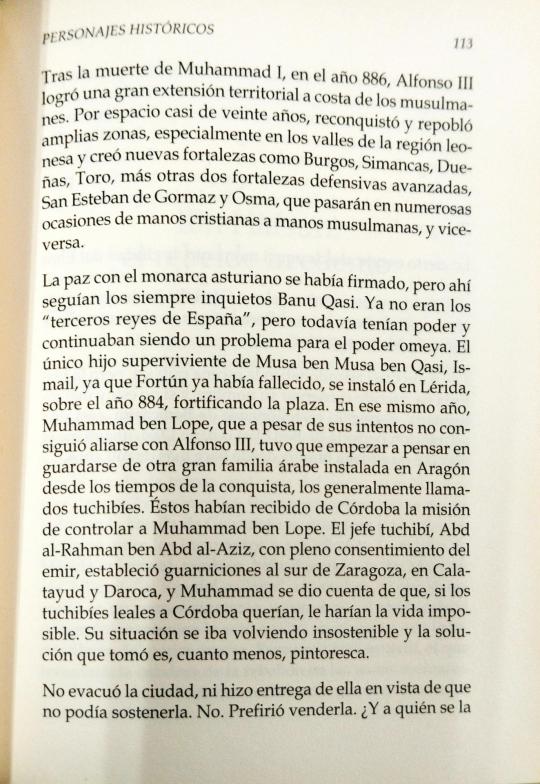
After the death of Muhammad I, in the year 886, Alfonso III achieved great
territorial extension at the expense of the Muslims. For almost twenty years, reconquered and repopulated large areas, especially in the valleys of the Leonese region and created new fortresses such as Burgos, Simancas, Dueñas, Toro,
plus two other advanced defensive fortresses, San Esteban de Gormaz and Osma, that will pass on numerous occasions from Christian hands to
Muslims, and viceversa.
Peace with the Asturian monarch had been signed, but there were still the always
restless Banu Qasi. They were no longer the "third kings of Spain", but they still had power and continued to be a problem for the Umayyad power. The only surviving son of Musa ben Musa ben Qasi, Ismail, since Fortun had already deceased, settled in Lleida, around the year 884, fortifying the stronghold. In that same year, Muhammad ben Lope, who despite his attempts did not manage ally with Alfonso III, had to start thinking about guarding against another great Arab family installed in Aragon since the times of the conquest, the generally called tuchibíes. These had received the mission from Córdoba
to control Muhammad ben Lope. The Tuchibi chief, Abd al-Rahman ben Abd
al-Aziz, with the full consent of the emir, established garrisons south of Zaragoza, in Cala-tayud and Daroca, and Muhammad realized that, if the tuchibís loyal to Córdoba wanted, they would make his life impossible. His situation was becoming unsustainable and the solution he took is, to say the least, picturesque.
He did not evacuate the city, nor did he surrender it since he could not sustain it.
No. He preferred to sell it. And who did

he sell It to? Well, to the Umayyads, who had gone through so much to reconquer it, without achieve it! The sale was formalized between the Umayyad general Hashim ben Abd al-Aziz through Muhammad ben Lope's brother-in-law, the Count of Pallars.
However, the Arab chroniclers do not agree. Generally, this is the version that seems most true, but there are also historians like Ibn Jaldún, who say that Zaragoza was besieged and taken by storm.
The truth is that, from that moment, the city of the Ebro passed into Umayyad obedience, and in its government, representatives faithful to Córdoba succeeded until... six years later the Tuchibíes are the ones who rise to power
on the Upper March!
The Banu Qasi left the public scene, but history has wanted keep their name, and if I am not misinformed, a town of Castellò, Benicasim, almost a perfect adaptation of Ben Qasi or Banu Qasi, maintains the name of that family for more than a thousand years.
#al andalus historical figures#al andalus personajes históricos#bookscans#bookblr#al andalus#al andalus history#historyblr#spanish history#banu qasi#musa ibn musa#emirate of cordoba#history#book scans
8 notes
·
View notes
Text
7th part of the bookscans of Al Andalus. Historical Figures, here's the previous part
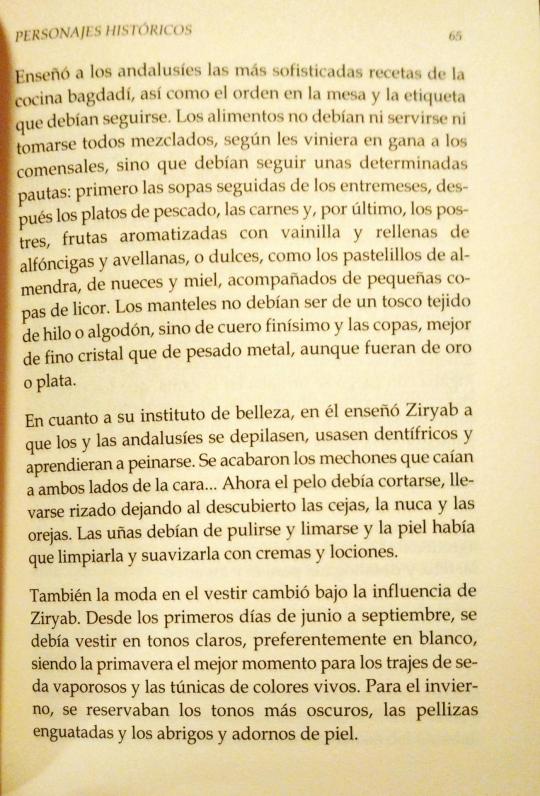
He taught the Andalusians the most sophisticated recipes of Baghdad cuisine, as well as the order at the table and the etiquette that had to be followed. The food should not even served or taken all mixed, as the diners wanted, but they had to follow certain guidelines: first the soups followed by the hors d'oeuvres, then the fish dishes, the meats and, finally, the desserts, fruits flavored with vanilla and stuffed with alphoncigas and hazelnuts, or sweets, such as almond, walnut and honey pastries, accompanied by small glasses of liquor. The tablecloths should not be of a coarse woven linen or cotton,nbut of very fine leather and the cups, better of fine crystal than of heavy metal, even if they were gold or silver.
As for his beauty institute, Ziryab taught the Andalusian to shave their hair, use toothpaste and to comb their hair. The strands that fell on both sides of the face ended... Now the hair had to be cut, worn curly, revealing the eyebrows, the nape of the neck and the ears. Nails should be polished and filed and the skin had to be cleaned and softened with creams and lotions.
Fashion in clothing also changed under the influence of Ziryab. Since the first days from June to September, they had to dress in light colors, preferably in white, spring being the best time for suits of gauzy silk and brightly colored tunics. For winter, they reserved the darker tones, the quilted pelisses and the fur coats and decorations.
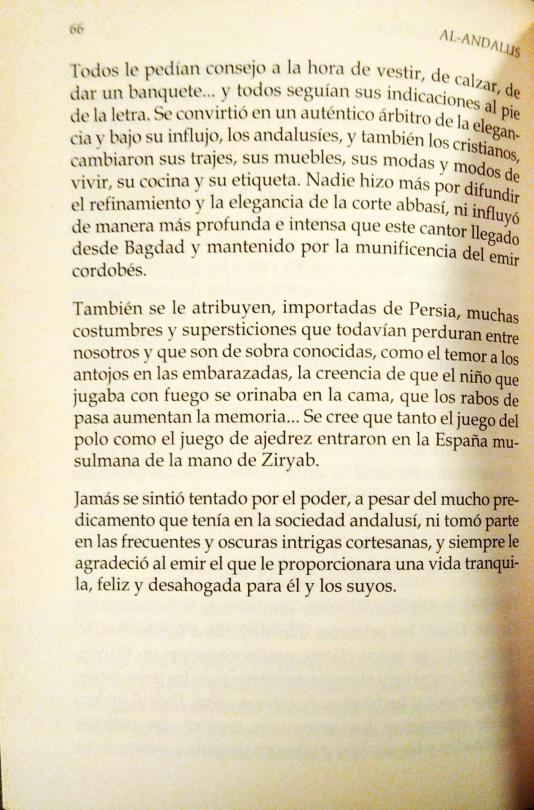
Everyone asked him for advice when it came to dressing, fitting shoes, giving a banquet... and everyone followed his instructions fully. It became a real
arbiter of elegance and under his influence, the Andalusians, and also the
Christians, changed their clothes, their furniture, their fashions and ways of living, their kitchen and their etiquette. No one did more to spread refinement and elegance of the Abbasid court, nor did he influence in a more profound and intense way than this singer arrived from Baghdad and maintained by the munificence of the Emir of Córdoba.
Also attributed to him, imported from Persia, are many customs and
superstitions that still exist among us and that are too known, such as the fear of cravings in pregnant women, the belief thatbthe boy who played with fire wet the bed, the tails of raisin increase memory... It is believed that both the game of polo and the game of chess entered Muslim Spain at the hands of Ziryab.
He never felt tempted by power, despite the much premedication that he had in Andalusian society, nor did he take part in the frequent and dark courtesans intrigues, and he always thanked the emir for providing him with a better, calm, happy and comfortable life for him and his people.

Tarub: the favorite of Abd al-Rahman II
All historians recognize that this emir was a complete womanizer. The young virgins, arriving from all corners, populated the harem of this man, so different from his father, the strict al-Hakam, who had bequeathed him a kingdom almost pacified, with the Treasury coffers filled to overflowing, which allowed him dedicate to all the pleasures that life can offer. Of his many concubines, wives and favorites, there was one whom it seems he loved more than all the others, Tarub, whose success with the caliph was perhaps due to her being surly, selfish and desired.
She must have been very beautiful, at least in the eyes of the enamored emir who, a man of great education and good poet, said of her: "Whenever I see the sun rise that illuminates reminds me of Tarub, a girl adorned with the trappings of beauty:
"The eye that contemplates it believes it sees a beautiful gazelle in it".
When he was not on an expedition, Abd al-Rahman II, like all sovereigns and
nobles of the era, went hunting, to the mountains of Sierra Morena or to the marshes of the Guadal-
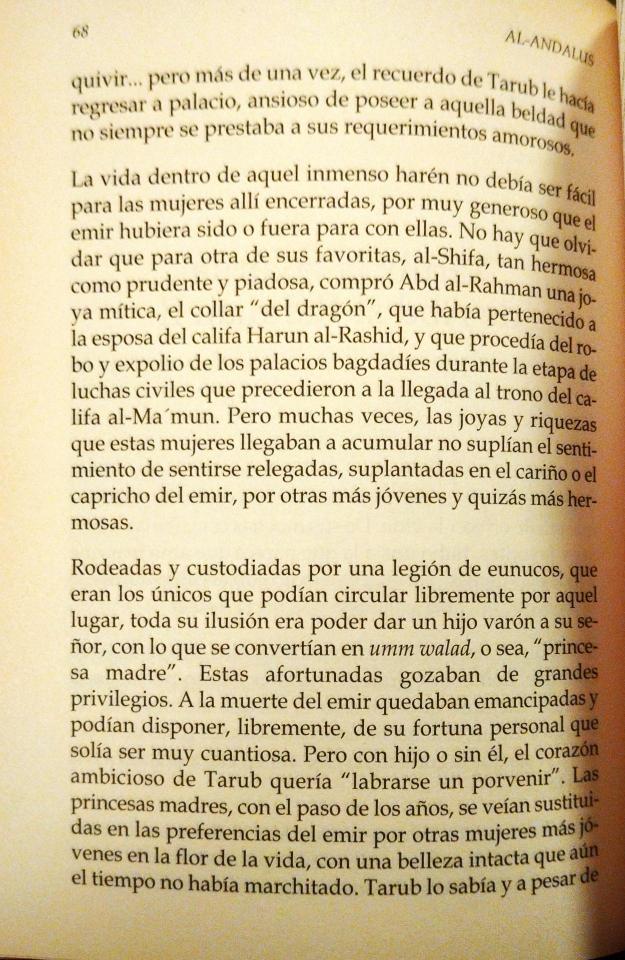
quivir... but more than once, the memory of Tarub made him return to the palace,
eager to possess that beauty who did not always respond to his amorous requirements.
Life inside that immense harem it couldn't have been easy for the women locked up there no matter how generous the emir had been or was towards them. There is no need to forget that for another of his favorites, al-Shifa, as beautiful as prudent and pious, Abd al-Rahman bought a mythical jewel, the dragon necklace, which had belonged to the wife of the caliph Harun al-Rashid, and that it came from the robbery and looting of the badgadi palaces during the period of the civil struggles that preceded the accession to the throne of the caliph al-Ma'mun. But many times, the jewels and riches that these women
accumulated did not make up for the feeling of feeling relegated, supplanted in the affection or whim of the emir, by others younger and perhaps more beautiful.
Surrounded and guarded by a legion of eunuchs, who were the only ones who could move freely through that place, their whole dream was to be able to give
a male child to their lord, with which they became umm walad, that is, "princess mother." These lucky ones enjoyed great privileges. To the death of the emir were emancipated and could freely dispose of
her personal fortune that used to be very large. But with or without a child, the
ambitious heart of Tarub wanted to “make a future for herself.” The princesses
mothers, as the years went by, saw themselves replaced in the prime of life,
with an intact beauty that time had not yet withered. Tarub knew it and despite
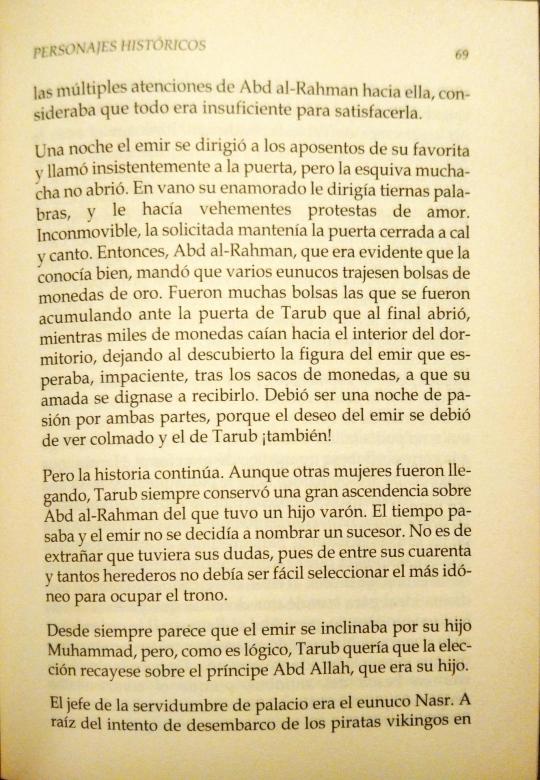
Abd al-Rahman's multiple attentions towards her, she considered that everything was insufficient to satisfy it.
One night the emir went to his favorite's chambers and called insistently at the door, but the elusive girl did not open it. In vain her lover spoke tender words to her, and made vehement protests of love. Unmovable, the requested one kept the door firmly closed. Then Abd al-Rahman, who clearly knew her well, ordered that several eunuchs carried bags of gold coins. There were many bags that were accumulating before the gate of Tarub that he finally opened, while thousands of coins fell into the bedroom, exposing the figure of the emir who waited, impatiently, behind the bags of coins, for his beloved would deign to receive him. It must have been a night of passion for both of us.
parts, because the emir's wish must have been fulfilled and Tarub's too!
But the story continues. Although other women arrived, Tarub always retained a great ancestry over Abd al-Rahman from whom he had a son. Time passed and the emir could not decide to name a successor. It is not surprising that he had his doubts, since among his forty heirs it couldn't be easy to select the most suitable one to occupy the throne.
It always seems that the emir was inclined towards his son Muhammad, but, of course, Tarub wanted the choice to fall to Prince Abd Allah, who was her son.
The head of the palace servants was the eunuch Nasr. Following the attempt to
landing of the viking pirates in

al-Andalus, Nasr had distinguished himself by his heroic behavior and by having defeated them in the battle that took place near Tablada. All this did that the emir appreciated him in a special way and that his influence at court was increasingly greater. Nasr and Tarub got along very well, they were both ambitious, and the princess mother, desperate to see her son named
successor decided, with the support of the eunuch, to plot a plot, quite sinister indeed, to ensure the much-desired succession to his son Abd Allah. The plot involved poisoning the prince who was presumed to be possible heir, Muhammad,... and by the way, and just in case the fact aroused suspicion, also ending the father, that is, the emir.
It was a very risky plan for Tarub but she was sure that with the complicity of Nasr, one of the strongest men at court and,
possibly the closest to the emir, she could not fail. And it happened that, in
those days, a very famous doctor, Harrán, arrived at the Cordoban court, who
came from Mesopotamia. Nasr asked him to prepare a drink poisoned and the doctor did not dare to deny him. Afterwards, he felt remorse and confessed the plot to another of the princess mothers, Farj, who
informed the emir of the conspiracy that was being hatched against him. The eunuch presented the deadly concoction to the emir, offering it to him as the ideal medicine to cure an ailment that he had been suffering from for some time, but Abd al-Rahman II ordered him to take it himself. Nasr was trapped and had no more remedy than drinking the poisoned drink. It was of little use to him to run in searchbof the antidote, because the counterpoison prepared by the doctor al-Harraní, wasn't effective and the eunuch died.
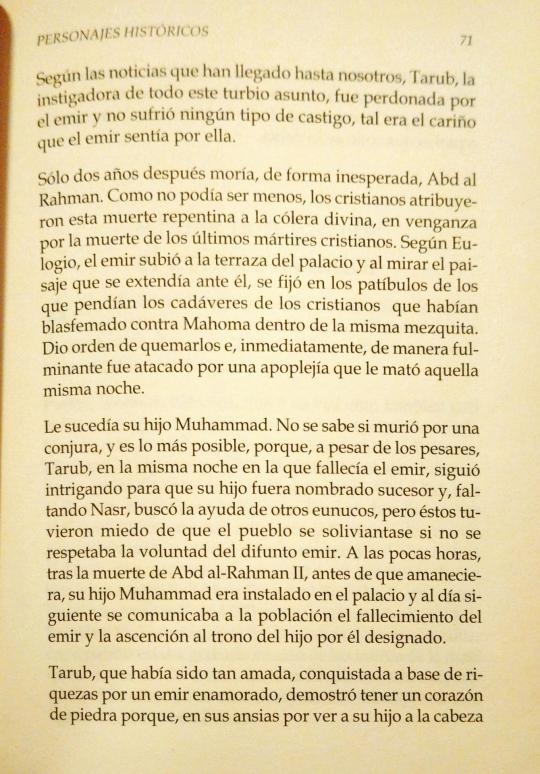
According to the news that has reached us, Tarub, the instigator of all this murky affair, was forgiven by the emir and did not suffer any type of punishment, such was
the affection that the emir felt for her.
Only two years later, Abd al Rahman died, unexpectedly. The Christians attributed this sudden death to divine anger, in
revenge for the death of the last Christian martyrs. According to Eulogio, the emir went up to the terrace of the palace and, looking at the landscape that stretched before him, noticed the scaffolds from which hung the corpses of the Christians who had blasphemed against Muhammad within the same mosque. He gave the order to burn them and, immediately, in a sudden manner, he was attacked by an apoplexy that killed that same night.
He was succeeded by his son Muhammad. It is not known if he died as a result of a conspiracy, and it is the most
possible, because, despite the regrets, Tarub, on the same night in which the
emir, continued to intrigue so that his son would be named successor and, with Nasr missing, she sought the help of other eunuchs, but they were afraid that the people would became angry if the will of the late emir was not respected. A few hours after the death of Abd al-Rahman II, before dawn, his son Muhammad wasinstalled in the palace and the next day the population was informed of the
death of the emir and the ascension to the throne of the son designated by him.
Tarub, who had been so loved, conquered with wealth by an emir in love, proved to have a heart of stone because, in her eagerness to see his son in the lead
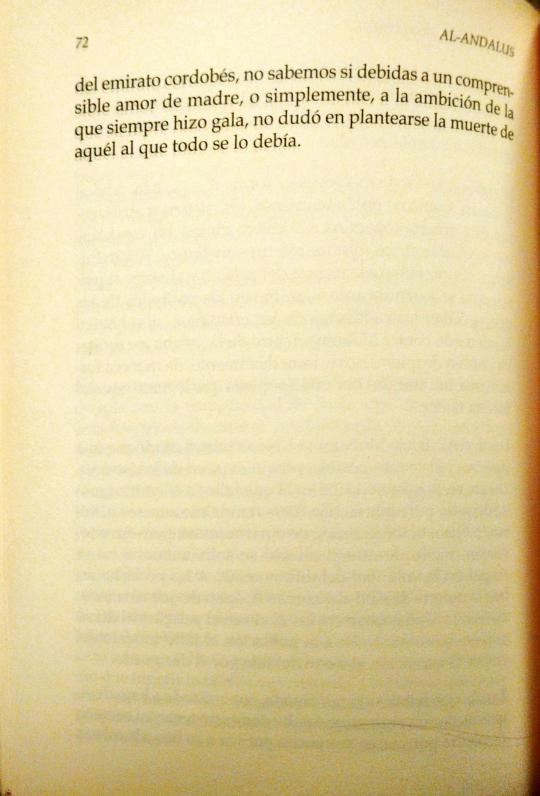
of the emirate of Cordoba, we do not know if due to an understandable love as a mother, or simply, to the ambition that she always displayed, she did not hesitate to consider the death of the one to whom she owed everything.

Abbas ben Firnas: the first aviator
Abd al-Rahman II was, without a doubt, the most cultured of all the emirs and
Hispano-Umayyad caliphs. Only one of his descendants, al-Hakam II, could compare him in terms of intellectual curiosity.
Poets, writers, philosophers, who in turn were also almost all astrologers, to whom
which the Muslims attached so much importance, were part of the court
by Abd al-Rahman. We will mention some of them, of great talent, who excelled in different areas of knowledge, such as Abd Allah ben al-Shamir, magnificent versifier; Ibrahim ben Sulayman al-Shamí, whose religious and mystical poems achieved great relevance throughout the Muslim world; Uthman ben al-Muthanna, grammarian, who became a preceptor to the royal princes; Said ben Farach al-Rashshash, who knew more than 4,000 mnemonics poems by heart and his brother Muhammad, who established the measurement of the Andalusian cubit, whose pattern was engraved on one of the walls of the main mosque from Córdoba... The list of wise men would be very long. But among all of them the figure of Abbas ben Firnas is especially important.
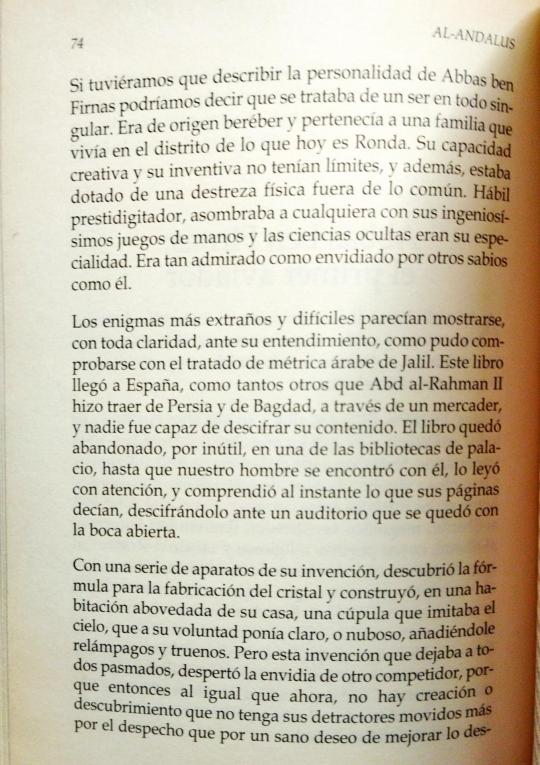
If we had to describe the personality of Abbas ben Firnas we could say that it was a being in every way singular. He was of Berber origin and belonged to a family that lived in the district of what is now Ronda. His creative ability and his inventiveness had no limits, and in addition, he was endowed with physical dexterity out of the ordinary. Skilled conjurer, he amazed anyone with his ingenious sleight of hand and occult sciences were his specialty. Was
as admired as envied by other wise men like him.
The strangest and most difficult enigmas seemed to show themselves, with complete clarity, before their understanding, as could be verified with the treatise on Arabic metrics of Jalil. This book arrived in Spain, like so many others that Abd al-Rahman II had brought
from Persia and Baghdad, through a merchant, and no one was able to decipher his content. The book was abandoned, as useless, in one of the libraries of palace, until our man came across it, read it carefully, and instantly understood what its pages said, deciphering it before a
audience that was left with their mouths open.
With a series of devices of his invention, he discovered the formula for the manufacturing glass and built, in a vaulted room in his house, a dome that imitated the sky, which at will made it clear or cloudy, adding lightning and thunder. But this invention that left everyone stunned, aroused the envy of another competitor, because then just as that now, there is no creation or discovery that does not have its detractors, motivated more by spite than by a healthy desire to improve what was
#al andalus historical figures#al andalus personajes históricos#book scans#bookblr#historyblr#al andalus#al andalus history#ziryab#zyriab the singer of baghdad#abu l-hasan ali ibn nafi`#abd al rahman ii#abd al rahman ii of córdoba#tarub#abbás ibn firnás#emirate of cordoba#spanish history#tw death#tw mysoginy#(for tarub's chapter)
11 notes
·
View notes
Text
Fifth part of the bookscans of Al Andalus. Historical Figures, here's the previous part
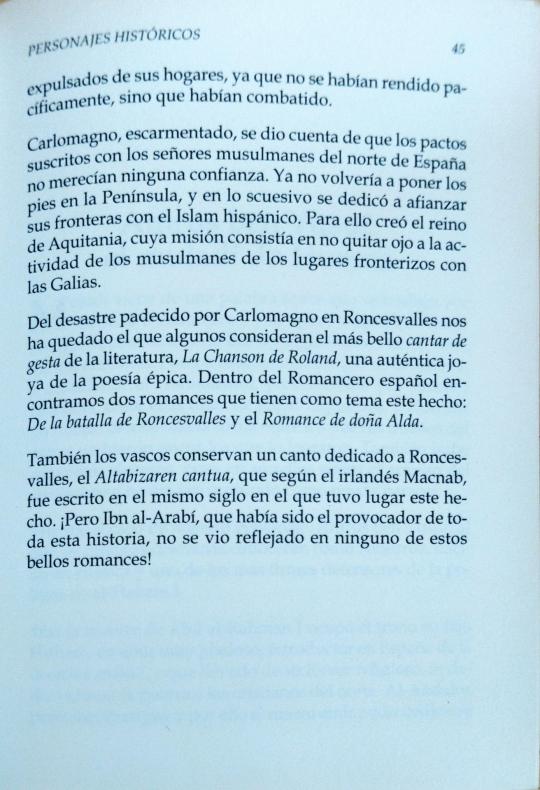
expelled from their homes, since they had not surrendered peacefully, but had fought.
Charlemagne, chastened, realized that the pacts signed with the Muslim lords of northern Spain deserved no trust. He would never set foot on the Peninsula again, and subsequently dedicated itself to strengthening its borders with
Hispanic Islam. For this he created the kingdom of Aquitaine, whose mission
consisted of not taking our eyes off the activity of the Muslims of the
places bordering Gaul.
From the disaster suffered by Charlemagne in Roncesvalles we have
remains what some consider the most beautiful song of deeds of literature, La Chanson de Roland, an authentic gem of the epic poetry. Within the Spanish Ballads we find two romances that have this fact as their theme: Of the battle of
Roncesvalles and the Romance of Doña Alda.
The Basques also preserve a song dedicated to Roncesvalles, the Altabizaren cantua, which according to the Irishman Macnab, was written in the same century in which this event took place. But
Ibn al-Arabí, who had been the originator of this whole story, was not reflected in any of these beautiful romances!
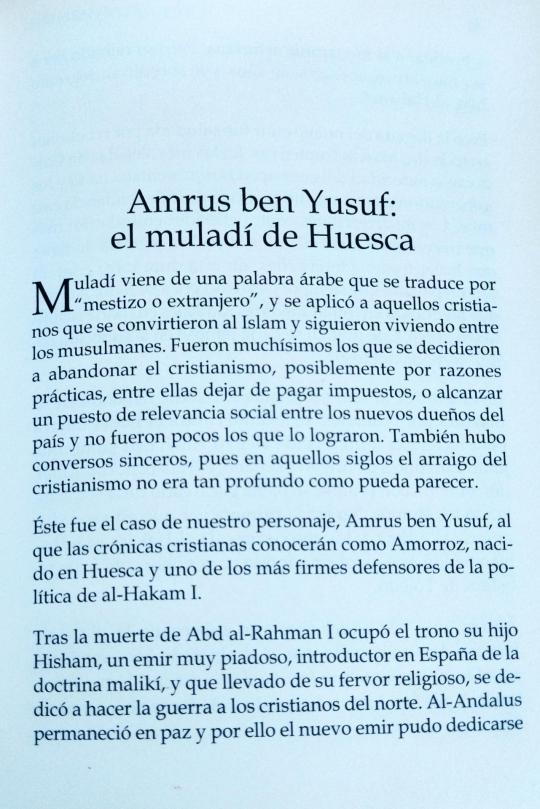
Amrus ben Yusuf:
the muladí of Huesca
Muladí comes from an Arabic word that translates as "mixed race or foreigner", and was applied to those Christians who converted to Islam and continued living among the Muslims.
There were many who decided
to abandon Christianity, possibly for practical reasons, including stopping paying taxes, or reaching a position of social relevance among the new owners of the country and there were not a few who achieved it. There was also sincere converts, since in those centuries the roots of the Christianity was not as deep as it may seem.
This was the case of our character, Amrus ben Yusuf, whom the Christian chronicles will know him as Amorroz, born in Huesca and one of the staunchest defenders of the policies of al-Hakam I.
After the death of Abd al-Rahman I, his son Hisham, a very pious emir, introducer of the Maliki doctrine in Spain, and who
Driven by his religious fervor, he dedicated himself to waging war on the Northern Christians. Al-Andalus remained at peace and therefore the new emir was able to dedicate himself
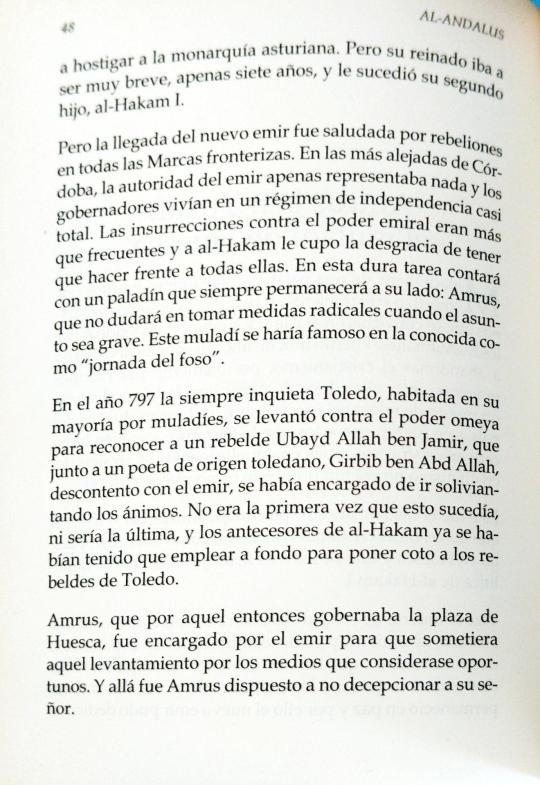
to harass the Asturian monarchy. But his reign was to be very short, just seven years, and was succeeded by his second son, al-Hakam I.
But the arrival of the new emir was greeted with rebellions in all the border marches. In the most remote areas of Córdoba, the authority of the emir hardly represented anything and the governors lived in a
regime of almost total independence. The insurrections against the power of the emirate were more than frequent and al-Hakam had the unfortunate luck to have to face them all. In this hard task, he will have a paladin who will always be at his side: Amrus, who will not hesitate to take radical measures when the matter is serious. This muladí would become famous on what was known as the “day of the pit.”
In the year 797, the always restless Toledo, inhabited mostly by muladíes, rose up against the Umayyad power to recognize a
rebel Ubayd Allah ben Jamir, who together with a poet of Toledo, Girbib ben Abd Allah, dissatisfied with the emir, had
in charge of calming down the spirits. It wasn't the first time this happen, nor would it be the last, and al-Hakam's predecessors had already had to work hard to put a stop to the rebels of Toledo.
Amrus, who at that time ruled the stronghold of Huesca, was commissioned by the emir to subdue that uprising by the means that it considers opportune. And there went Amrus willing not to disappoint his lord.
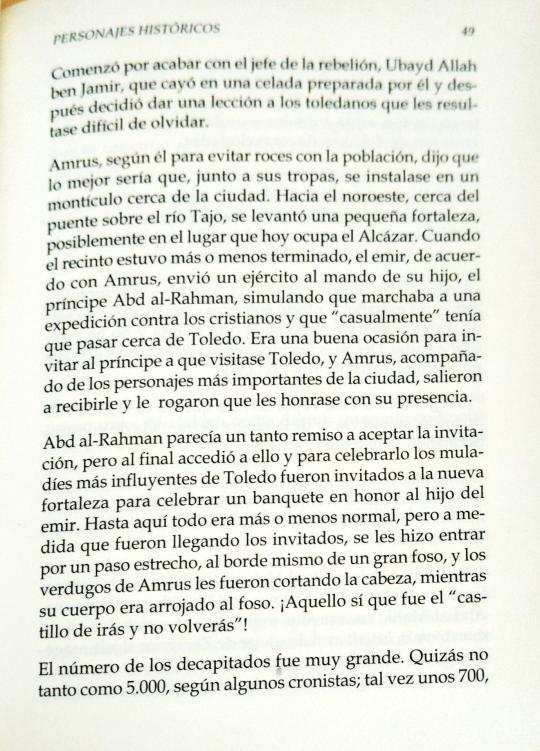
He began by eliminating the leader of the rebellion, Ubayd Allah ben Jamir,
who fell into a trap prepared by him and then decided to give a lesson to the people of Toledo that they would find difficult to forget.
Amrus, according to him to avoid friction with the population, said that the best
would be that, along with his troops, he would settle on a mound near the
city. Towards the northwest, near the bridge over the Tagus River, rose
a small fortress, possibly on the site now occupied by the Alcazar. When the enclosure was more or less finished, the emir, in agreement with Amrus, he sent an army under the command of his son, the prince Abd al-Rahman, pretending that he was going on an expedition against the
Christians and that "coincidentally" had to pass near Toledo. It was a good occasion to invite the prince to visit Toledo, and
Amrus, accompanied by the most important people of the city, they came out to receive him and begged him to honor them with his presence.
Abd al-Rahman seemed somewhat reluctant to accept the invitation, but
In the end he agreed to it and to celebrate it the most influential mula-díes
of Toledo were invited to the new fortress to celebrate a banquet in honor of the emir's son. Until then everything was more or less normal, but as the guests arrived, they became enter through a narrow passage, at the very edge of a large ditch, and the Amrus's executioners cut off their heads, while their bodies was thrown into the pit. That was the " castle of you will go and no you will come back"!
The number of those beheaded was very large. Maybe not as much as
5,000, according to some chroniclers; maybe about 700

being a very high number. What the leading class of Toledo was thus beheaded and the terrible impression produced by this event remained, for a long time, both among the Muslims and among the muladies of Toledo and from other cities.
Dozy narrates that terrible day like this: "At daybreak, a doctor that had not seen anyone leave through either of the two door, became suspicious and asked the people gathered near the entrance of the castle what had happened to the guests who had arrived early.
"They must have gone out through the other door," they answered- It's strange!-the doctor then objected -; I have been for some time at the other door and I haven't seen anyone leave. After watching the steam rising above the walls,
exclaimed:
Unfortunates! I swear to you that this vapor is not the smoke of a feast,
but the vapor of the shed blood of your brothers, beheaded"
When things got really bad, al-Hakam knew that he could count on Amrus and so he also entrusted him with the submission
of Zaragoza, the capital of the Upper March, as seditious as Toledo.
After the advent of al-Hakam, the two best generals of his father, Abd al-Karim ben Mugith and his brother, Abd al-Malik, in
those moments at enmity with the new emir, they tried to evict the Aragonese chief Bahlul ben Marzuq from Zaragoza, to
They settled in the city, but they did not succeed. He got a Cordoban army, and
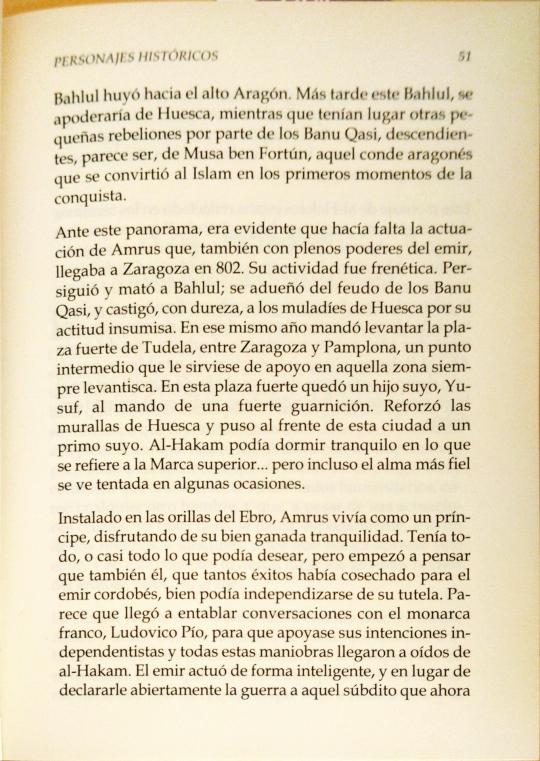
Bahlul fled towards upper Aragon. Later this Bahlul, would take over Huesca, while other small rebellions by the Banu Qasi took place, who were descendants, it seems, of Musa ben Fortún, that Aragonese count who converted to
Islam in the first moments of the conquest.
Given this panorama, it was evident that the action of Amrus who, also with full powers of the emir, came to Zaragoza in 802. Its activity was frenetic. Persecuted and killed Bahlul; took over the fiefdom of the Banu Qasi, and harshly punished
to the muladíes of Huesca for their rebellious attitude. In that same
year he ordered the construction of the stronghold of Tudela, between Zaragoza and Pamplona, an intermediate point that would serve as support in
that always upheaval area. In this stronghold there was his son, Yusuf, commanding a strong garrison. He reinforced the walls of Huesca and put one of his cousins in charge of this city.
Al-Hakam could sleep peacefully when it came to the Upper March... but even the most faithful soul is tempted in some
occasions.
Installed on the banks of the Ebro, Amrus lived like a prince, enjoying your well-earned peace of mind. He had everything, or almost everything he could want, but he began to think that he too,
which had garnered so much success for the emir of Cordoba, could become independent of his tutelage. It seems that he came to engage conversations with the Frankish monarch, Louis the Pious, so that
supported their independence intentions and all these maneuvers reached al-Hakam's ears. The emir acted
intelligent, and instead of openly declaring war on that subject that now
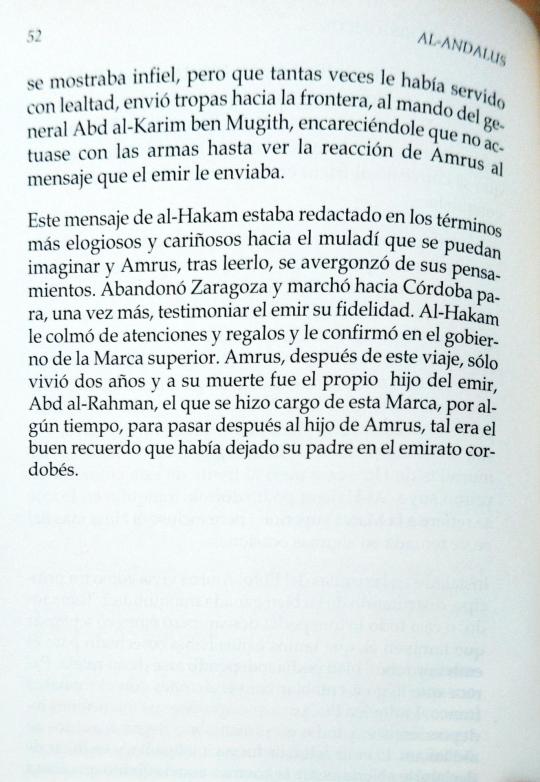
showed to be unfaithful, but that he had served him so many times with loyalty, he sent troops to the border, under the command of General Abd al-Karim ben Mugith, urging him not to act with the
weapons until seeing Amrus's reaction to the message that the emir gave him.
This message from al-Hakam was written in the most praiseworthy and affectionate towards the muladí that you can imagine and Amrus, after reading it, was ashamed of his thoughts. He left Zaragoza and marched towards Córdoba to, once again, bear witness the emir his fidelity. Al-Hakam showered him with attention and gifts and confirmed him in the government of the Upper March. Amrus, after
of this trip, he only lived two years and at his death the son of the emir, Abd al-Rahman, took charge of this March, for
some time, to later pass to the son of Amrus, such was the good memory that his father had left in the emirate of Cordoba.
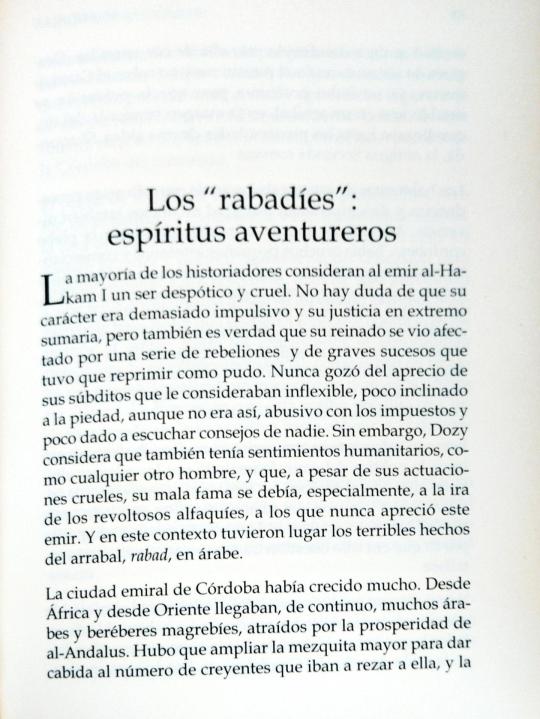
The "Rabadis":
adventurous spirits
Most historians consider the emir al-Ha-kam I despotic and cruel. There is no doubt that his character was too impulsive and his justice extremely summary, but it is also true that his reign was affected by a series of rebellions and serious events that he had to repress as best he could. He never enjoyed the appreciation of his subjects who considered him inflexible, little inclined to piety, although it was not like that, abusive with taxes and little given to listening advice from no one. However, Dozy believes that he also had humanitarian feelings, like any other man, and that, despite of his cruel actions, his bad reputation was due, especially, to the
wrath of the rebellious alfaquis, whom this emir never appreciated. And in this context, the terrible events of the suburb, rabad in Arabic, took place.
The emiral city of Córdoba had grown a lot. From Africa and from the East any Arabs and Berbers from the Maghreb continually arrived attracted by the prosperity of al-Andalus. The mosque had to be expanded larger to accommodate the number of believers who came to pray to it, and

The city was expanding beyond its walls. After the Roman bridge over the Guadalquivir was restored, there was no longer a problem for the population to settle in a suburb on the left bank of the river, which reached the vicinity
from a village, Shaqunda, ancient Roman Secunda.
The inhabitants of this suburb were of very diverse origins and they carried out a multitude of diverse jobs. Besides
of what could be considered the Cordoba plebs, there were many small Mullawad and Christian artisans and merchants, but
due to its proximity to the main mosque and the emiral palace, many Cordobans who were employed, either in the mosque or in the palace, they settled there. Among this diverse population, also found the alfaquíes, religious leaders of the doctrine
Malikí, who had reached a very prominent position and a very notable influence at court, especially with the emir
Hisham, father of al-Hakam I.
This suburb will soon become a focus of discontent towards the emir's policy, promoted by the same alfaquies who with
al-Hakam had neither the appreciation nor the influence that they achieved with
his predecessor. On the other hand, in the city al-Hakam did not enjoy of many sympathies so it was only a matter of time before the situation exploded.
And it happened that one day a rumor spread through the city that seventy-two leading citizens had been executed and that their corpses were going to be exposed, crucified, on the right bank
of the Guadalquivir. The mood be-

gan to exalt, without knowing or without asking themselves the reason for these executions. What happened was that a plot had been hatched to overthrow the emir
and put in his place one of his cousins, the Umayyad Muhammad ben al-Qasim. Many notable people from the Córdoba of that time were involved in this conspiracy.
Al-Hakam's cousin pretended to accept the proposal, but was immediately
to tell the emir, also providing him with the list of the conspirators. Inthat same day, the emir ordered them to be arrested and executed, taking advantage of the
occasion to order the murder of two of his uncles, sons of Abd al-Rahman I, who had been imprisoned since his ascension to the throne, possibly to prevent them from rebelling against him or challenging him for power. Between the crucified were figures of great social relevance, such as the
son of a cadi, a palace eunuch, a market inspector and even a alfaqui. The impression that this action produced in Córdoba could not be more negative towards the emir, and the discontent, already notable, increased.
There was a plotting everywhere, at any time of the day. In the mosques, in the markets, in the streets discontent was chewed, while everyone distrusted everyone, believing they saw spies and
confidants of the emir throughout the entire city.
Al-Hakam, aware of the mood, equipped himself withweapons, restored the walls, surrounded himself with a strong personal guard under the command of a Christian, Count Rabí, and prepared himself for the worst.
#book scans#al andalus. historical figures#al andalus. personajes históricos#al andalus#al andalus history#bookblr#historyblr#spanish history#sulayman ibn yaqzan ibn al-arabi#amrus ibn yusuf#rabadies#rabadi#al hakam i#al hakam i of córdoba#emirate of cordoba#umayyad emirate of córdoba#middle ages#rabadid dinasty#hisham i#hisham i of cordoba
9 notes
·
View notes
Text
10th part of the bookscans of Al Andalus. Historical Figures, here's the previous part

The Andalusian Vikings
The reign of Abd al-Rahman II was rich in events and one of them, that spread terror on the Andalusian coasts, was the arrival of the Vikings or Normans, whom the Muslims called machus, a word that could
translate as “idolaters” or “fire worshipers.”
Both Arab and Christian sources record, in their chronicles, the arrival to the coasts of the Iberian Peninsula from those fearsome pirates, who devastated, robbed and killed, wreaking havoc among the peaceful people and whose sad memory remained for a long time.
In the year 844 these pirates made an appearance on the Atlantic coast of the
Peninsula. It was the first time they had come there, although the year before,
They had taken the French city of Nantes, and going up the Loire they had
entered the Gironde River, reaching Bordeaux and Toulouse, through the Garonne.
One of their fleets moved south and the Normans landed in the coast of Asturias, very close to the city of Gijón. Then there was another disembark in Galicia, at the height, more or less, of A Coruña. There they were rejected and followed the direction of the Muslim Atlantic coasts.
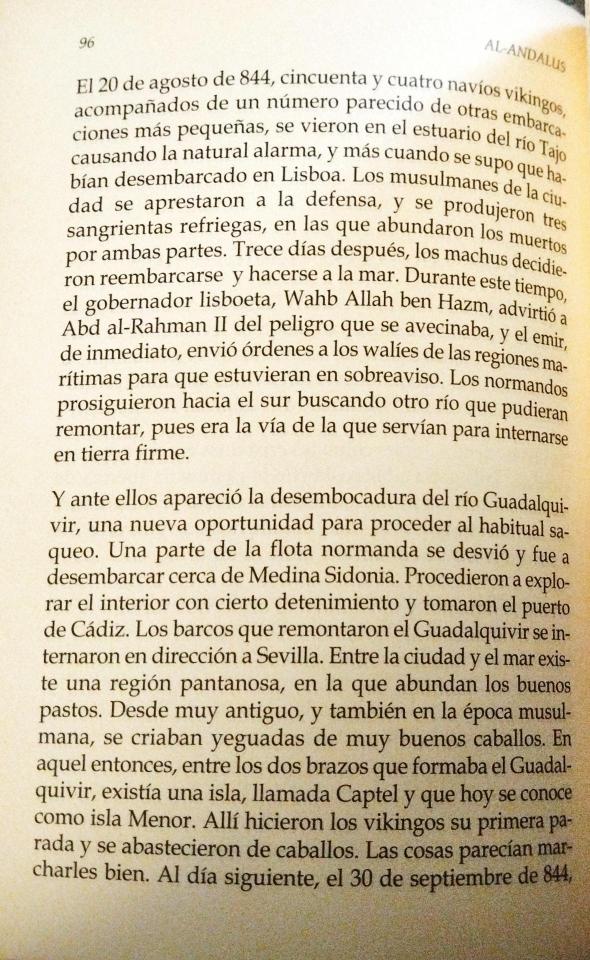
On August 20, 844, fifty-four Viking ships, accompanied by a similar number of other smaller vessels were seen in the estuary of the Tagus River causing natural alarm, and even more so when it was learned that they had landed in Lisbon. The Muslims of the city prepared the defense, and there were three bloody skirmishes, in which there were many dead on both sides. Thirteen days later, the Machus decided
reembark and put to sea. During this time, the Lisbon governor, Wahb Allah ben Hazm, warned Abd al-Rahman II of the danger ahead, and the emir immediately sent orders to the walis of the maritime regions so that they were on notice. The Normans continued south looking for another river that they could go up, since it was the route they used to go into dry land.
And before them appeared the mouth of the Guadalquivir river, a new opportunity to proceed with the usual looting. A part of the Norman fleet diverted and landed near Medina Sidonia. They proceeded to explore the interior at some length and took the port of Cádiz. The ships who went up the Guadalquivir headed towards Seville. Between city and the sea there is a swampy region, in which there are good
pastures. Since ancient times, and also in Muslim times, they were raised studs of very good horses. Back then, between the two arms that formed the Guadalquivir, there was an island, called Captel and which today is known as Minor Island. There the Vikings made their first stop and supplied themselves of horses. Things seemed to be going well. The next day, the 30th September 844,

Four ships reached the town of Coría del Río, located about four kilometers away from Captel. They disembarked, proceeded to total looting and murdered the population, in one of their typical performances.
Three days later the Norman fleet. continued upriver and before the frightened eyes of the Sevillians, the black sails of the pirate ships appeared.
The sad fate of the inhabitants of Coria del Río was known, and the terrified citizens rushed to organize themselves to resist, but the governor, no more scared than the others!, had fled towards Carmona. Lacking direction, they did what they could, sending to meet the machus' fleet
some ships, which were received with a shower of incendiary arrows and they all burned without any possibility of defense.
Seville was evacuated as quickly as possible, although not everyone left the city, some because of their health status, others because they are elderly and others
because they did not want to abandon their property, a useless precaution, since the Vikings, landing in Seville, killed them all. Women and children were taken captive, while a horrific looting of the city was carried out, which lasted seven days.
So much loot was obtained that the Norman ships were overcrowded, so much
of wealth and of frightened Muslim women who did not know what was going to happen to them in the hands of those barbarians from the north. They decided to return to base that they had established in Captel and disembark everything they had achieved, it was impossible to continue sailing with such an abundant and precious cargo.
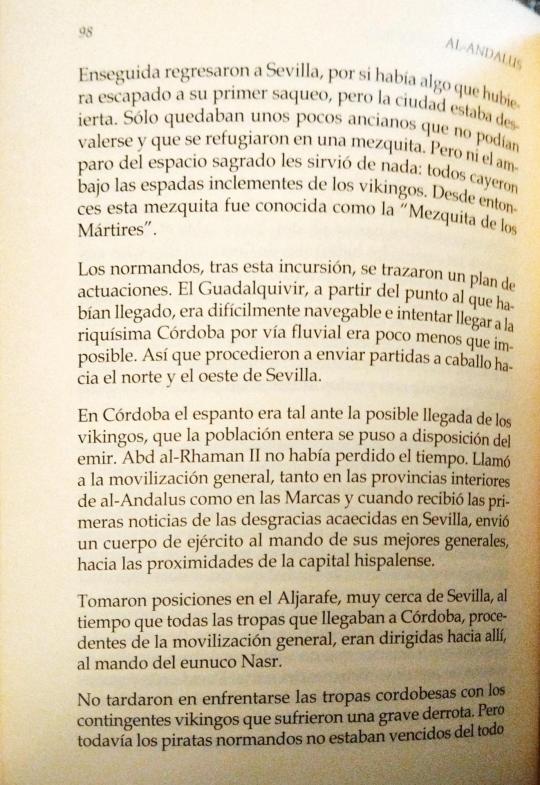
They immediately returned to Seville, in case there was anything that had escaped their first looting, but the city was deserted. There were only a few old people left who did not could help themselves and took refuge in a mosque. But not even the protection of sacred space was of no use to them: they all fell under the merciless swords of the vikings. Since then this mosque was known as the "Mosque of the
Martyrs".
The Normans, after this raid, drew up a plan of action. The Guadalquivir, from the point they had reached, was difficult to navigate and trying to reach the rich Córdoba by river was almost impossible.
So they proceeded to send horse parties to the north and west of Seville.
In Córdoba the fear was such at the possible arrival of the Vikings, that the entire population was placed at the disposal of the emir. Abd al-Rhaman II had not lost time. He called for general mobilization, both in the interior provinces of Al Andalus and in the Marches and when he received the first news of the misfortuned events in Seville, he sent an army under the command of his best
general, towards the outskirts of the capital of Seville.
They took up positions in Aljarafe, very close to Seville, while all the troops arriving in Córdoba, from the general mobilization, were headed there, under the command of the eunuch Nasr.
It didn't take long for the Cordoban troops to clash with the Viking contingents that
suffered a serious defeat. But still the Norman pirates were not completely defeated
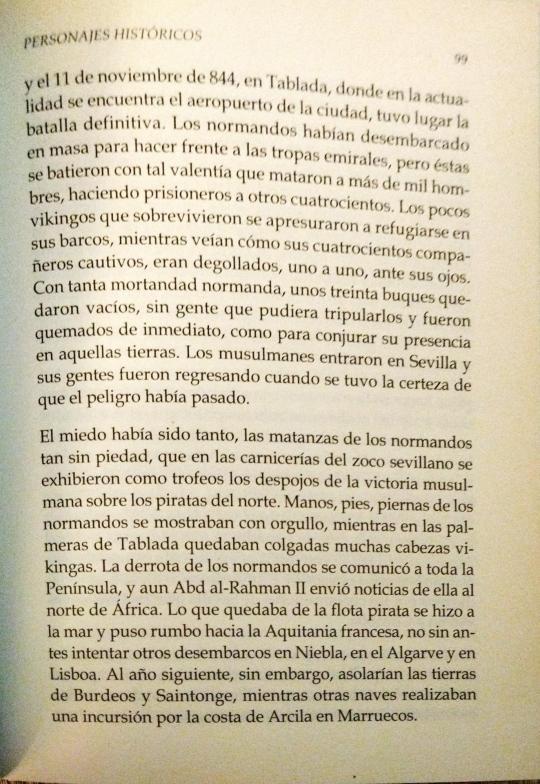
and on November 11, 844, in Tablada, where the city airport is nowadays located, the final battle took place. The Normans had landed en masse to confront the emiral troops, but they fought with such bravery that they killed more than a thousand men, taking prisoners to another four hundred. The few Vikings who survived rushed to take refuge in their ships, while they saw how their four hundred companions captives, their throats were beheaded, one by one, before their eyes. With so much Norman mortality, about thirty ships were left empty, without people who could man them and they were burned immediately, as if to ward off their presence in those
land. The Muslims entered Seville and its people returned when it was certain that the danger had passed.
The fear had been so great, the massacres of the Normans so mercilessly, that in
the butcher shops of the Sevillian souk, the remains of the Muslim victory over the northern pirates were shown as trophies. Normans hands, feet, legs, were showed with pride, while in the palm trees of Tablada many Viking heads were left hanging. The defeat of the Normans was communicated to the entire Peninsula, and even Abd al-Rahman II sent news of it to North Africa. What remained of the pirate fleet put to sea and headed towards the
French Aquitaine, but not before attempting other landings in Niebla, in the
Algarve and in Lisbon. The following year, however, they would ravage the lands of Bordeaux and Saintonge, while other ships made a raid along the coast of Asilah in
Morocco.
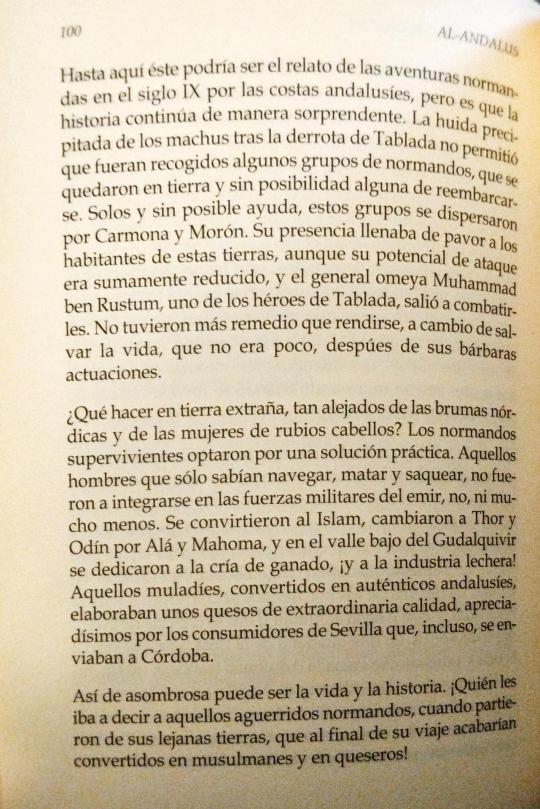
Up to this point this could be the story of the Norman adventures in the 9th century along the Andalusian coasts, but the story continues in an amazing way. The hasty flight of the Machus after the defeat of Tablada did not allow some groups of Normans to be collected, whichwere left on land and without any possibility of reembarking. Alone and without possible help, these groups dispersed through Carmona and Morón. Their presence filled the inhabitants of these lands with dread, although its potential for attack was extremely small, and the Umayyad general Muhammad ben Rustum, one of Tablada's heroes, went out to fight them. They had no more choice but to surrender, in exchange for saving one's life, which was no small thing, after their barbaric actions.
What to do in a strange land, so far from the Nordic mists and the women with blonde hair? The surviving Normans opted for a practical solution. Those men who only knew how to navigate, kill and loot, they were not going to join the emir's military forces, no, not at all. They converted to Islam, changed Thor and Odin for Allah and Muhammad, and in the lower valley of the Gudalquivir they dedicated themselves to cattle raising, and to milk industry! Those muladíes, converted into authentic Andalusians, made cheeses of extraordinary quality, greatly appreciated by consumers from Seville that were even sent to Córdoba.
That's how amazing life and history can be. Who was going to tell those brave Normans, when they left their distant lands, which at the end of their trip they would end up becoming Muslims and cheese makers!
#al andalus historical figures#al andalus personajes históricos#book scans#bookblr#historyblr#al andalus#al andalus history#emirate of cordoba#emirato de córdoba#history#andalusian vikings#vikingos andalusíes#spanish history#muhammad ibn rustum#nars#abd al rahman ii#abd al rahman ii of córdoba#nars abul-fath
9 notes
·
View notes